You are using an out of date browser. It may not display this or other websites correctly.
You should upgrade or use an alternative browser.
You should upgrade or use an alternative browser.
Reviews by Banbeucmas
Filters
Show only:
Loading…
Banbeucmas
100+ Head-Fier
Pros: One of the best treble responses I have ever heard
Clean bass line
Amazing details and resolution
Coherent
Great timbre
Clean bass line
Amazing details and resolution
Coherent
Great timbre
Cons: The bass might be too clean, which shares both pro and cons of the ThieAudio Monarch
A bit boxy for vocal, that or it will be a bit recessed for female vocal
Average staging performance
Size is a bit too big, might be uncomfy for some ears
A bit boxy for vocal, that or it will be a bit recessed for female vocal
Average staging performance
Size is a bit too big, might be uncomfy for some ears

If don't know about Symphonium Audio or Subtonic by the time of this writing, then I don't blame you - until I got the tour unit I don't either. Though by chance if you know @toranku, then you might know a bit about Subtonic, though that's as far as I can say.
The Symphonium Helios is a collaboration IEM between Subtonic and Symphonium. If anything, this work also marks the first appearance of Subtonic in the market. Incidentally, with its pricing of ~1000$, both brands are showing their confidence in this collaboration by challenging the renowned top dog of the IEM chamber as well.
Will this be a triumph of the underdog or just a show-off like someone who all barks with no bites, let's find out.
This review is a copy from my blog, with some edit to fit the Head-fi review format
My listening preference and gear can be found here.
Information:
- Drivers: 4BA
- Price: 1099$
- Purchase link: https://www.symphoniumaudio.com/products/helios
Build and Accessories:
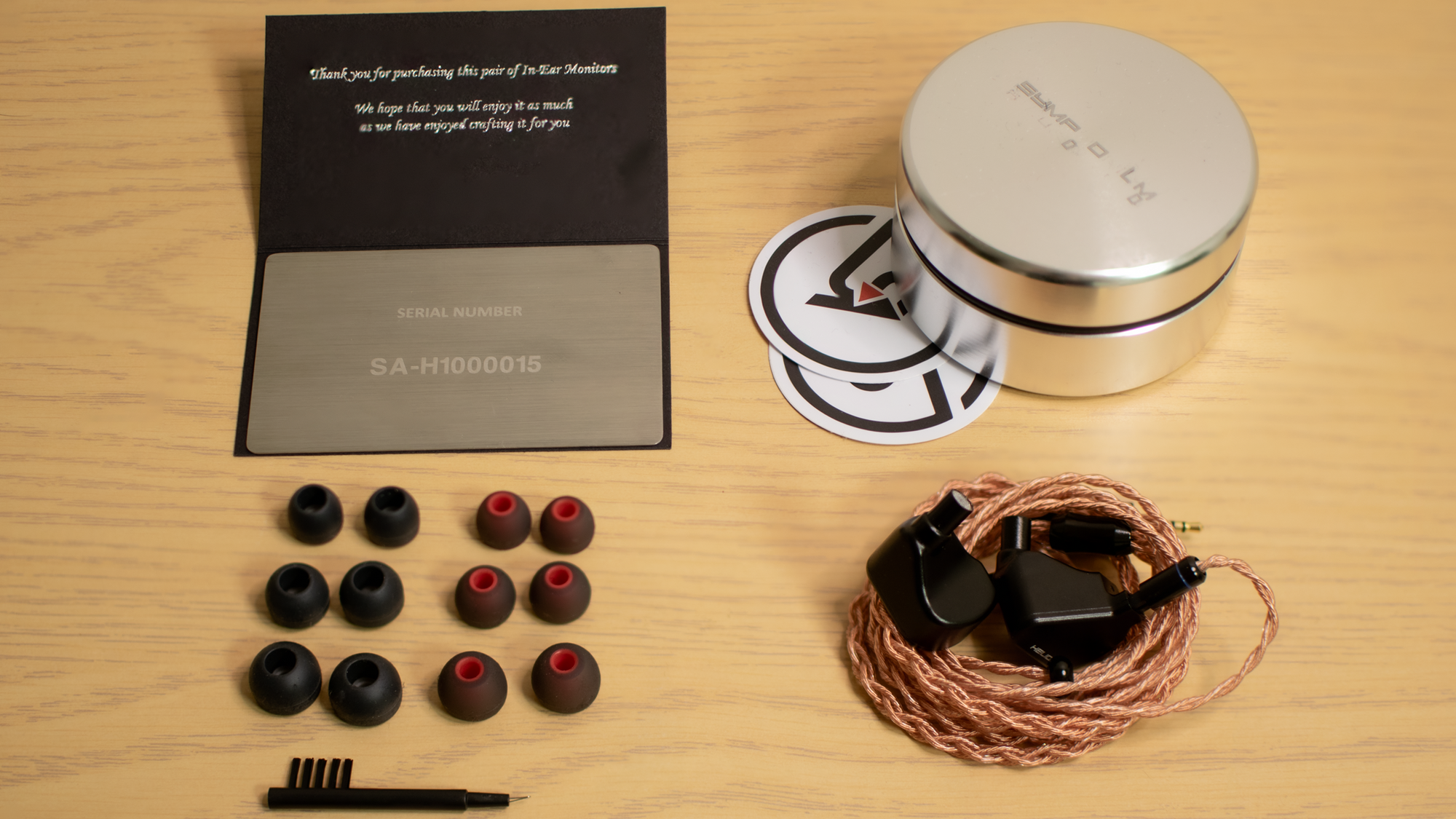
- 3 pairs of AZLA SednaEarfit ear tips (S/M/L)
- 3 pairs of silicone ear tips (S/M/L)
- Balanced 2.5mm 2-pin 0.78mm cable
- Brushes
- The IEM itself
Nothing much to say about the accessories except that the metal case is quite durable. It's solid, which might help if I want to get someone to the hospital if I try hard enough. My only complaint is that the lettering on the case does start to wear off during my usage. They surprisingly are just a bunch of stickers and not etched into the case.
The Symphonium Helios fit itself is... odd. I am not that irritated by its shape as much as how there seems to be a pocket of air inside of my canal every time I wear it. Some other aspects of the nozzle design need to be considered as well, such as a long and wide nozzle. For people who are aware of the Blessing 2 design, imagine the Helios fit in a similar fashion. Admittedly it's not as wide, but you might want a deep fit on this set for sound quality reasons (which I will mention in the analysis).Not that it ruins the quality of the case itself anyway, but on to a cosmetic point...
Other than that, I cannot think of any other potential problem for the wearers. Maybe its triangular design can be irritating (It's a bit similar to the Tanchjim Oxygen or the Hana if you know about it), but that's about it. The black shell design of the Helios sure is charming on some fronts while being solid and durable too.
The included Sedna tips is nice to have, though for my ear it wasn't the most optimal (there was no SS size). For the sake of information, I have tested the Helios with:
- AZLA SednaEarfit - SS size (Yes, I bought this)
- Acoustune AET07 - S size
- Sony Hybrid - SS size
- Final E - SS size
The review will mainly based on the AZLA SednaEarfit and the Acoustune AET07
Sound:
Standalone analysis:
One look at the graph might consider the Helios to be Mild-V. While my impression partly agrees with this notion, the Helios, in my opinion, follows a Neutral with Sub-bass boost sound signature, though some might regard the Helios as neutral bright even.
The Symphonium Helios Frequency response can be seen from the Frequency Response Index
Yes, ~10dB of bass gain is a lot here, though if you pay attention to the bass shelf starting at 200Hz as well as look at how lean the bassline is, you will realize that the boost is relatively clean, too clean even.
That leads me to the first problem with the Helios, which is:
In my ThieAudio Monarch review that was written a year ago, I had one remark about its bass performance:The Helios has the ThieAudio Monarch symdrome (somewhat).
Speaking of sub-bass, it's excellent and it is one of the reasons why I would recommend this IEM for sub-bass lovers due to how satisfying it is. That being said, while the 150Hz boost keeps the bassline clean from bleeding into the mid-range, I sometimes find myself wanting a bit more punch for some of my electronic tracks.

Let me remind you that as far as description goes, this is just a relative comparison. But the impression of the hefty mid-bass impact when listening to the Helios is what reminds me of this notion of the Monarch.
And again, this is not by any means a bad thing, and I would prefer a clean bassline to an overly bloated bass performance any day. But putting myself inside the shoes of a bass head?
That said, the similarities with the Monarch end there. While the Monarch remains forward with some of the high-vocalists that I listened to (Nanahira, Natsume Itsuki...), the Helios does the opposite as these types of vocals tend to range from "neutral" to "recessed." Female vocalists who utilize lower ranges of frequencies like Nakae Mitsuki on the other hand, work well despite being a little bit boxy. It's due to the former trait of the Helios that I tend to crank the Helios volume up a bit for vocal songs that don't employ an overwhelming number of instruments, though that alone doesn't fix its problem when presenting bowed string instruments like cello or violin.Then you might as well look for other IEMs unless quality is what you are longing for more than quantity.
Its staging performance also isn't the best either. The Helios tends to lack some width and its imaging presentation resembles a "blob effect" sensation where you can only point out the difference between left, center, and right.
Mind you, this effect is not as apparent as a lot of IEM out there, but that alone isn't enough for me to consider it above average anyway.Or for anyone who knows the "flowery" term, the Helios isn't as diffuse in its stage performance as I would prefer.
Out of those
This is the aspect that I love the most about this IEM; the Helios simply just sparkles without any sense of unevenness or weird "zing" that I experienced with other IEMs, like the 64 Audio U18s. It achieves all of this while remaining fast and sharp. And damn it is an understatement if I don't say that the Helios treble performance carries a lot here considering the number of IEMs that I enjoy purely because of their treble performance, like the Sony IER-Z1R, ThieAudio Monarch...The Helios treble performance is among one of the best that I have experienced
That said, knowing how I usually wear these IEMs, I have to bring out my disclaimer about how you should deep fit these IEMs as it tends to vary a lot between a person and tip choices. Otherwise, don't come back to me and complain how spikey the treble on the Helios is.
But overall, the Helios treble received no complaints; it works so well with some of my favorite Japanese/Chinese Oriental tracks, from instrumental to just plain Electronic EDM.
Next up,
Now, this isn't saying that the Helios has the best detail retrieval ability out there, but it's among one of the brightest contenders on my list. This with the clean tuning and treble performance makes the Helios the perfect detail and clarity machine as these qualities (imho) just amplify each other once executed perfectly. Some might consider the Helios being technical for this reason and I agree. But due to its tonal performance, it stays out of the "dry" criticism that I usually mention with IEMs like the Etymotic ER4S/SR/XR.The Helios detail retrieval is suprisingly terrific
Which is mostly an afterthought at this point considering what I have said above about the Helios. But it's worth mentioning anyway. Note that I consider coherency and timbre as two different things despite having small relations to each other. But for the Helios, it doesn't matter anyway as it keeps the whole sound spectrum streamlined without any serious common timbral quirks that I found in BA/Multi-BA sets.And this is not to mention it's coherency and timbre
Select Comparisons:
vs Unique Melody MEST MKII: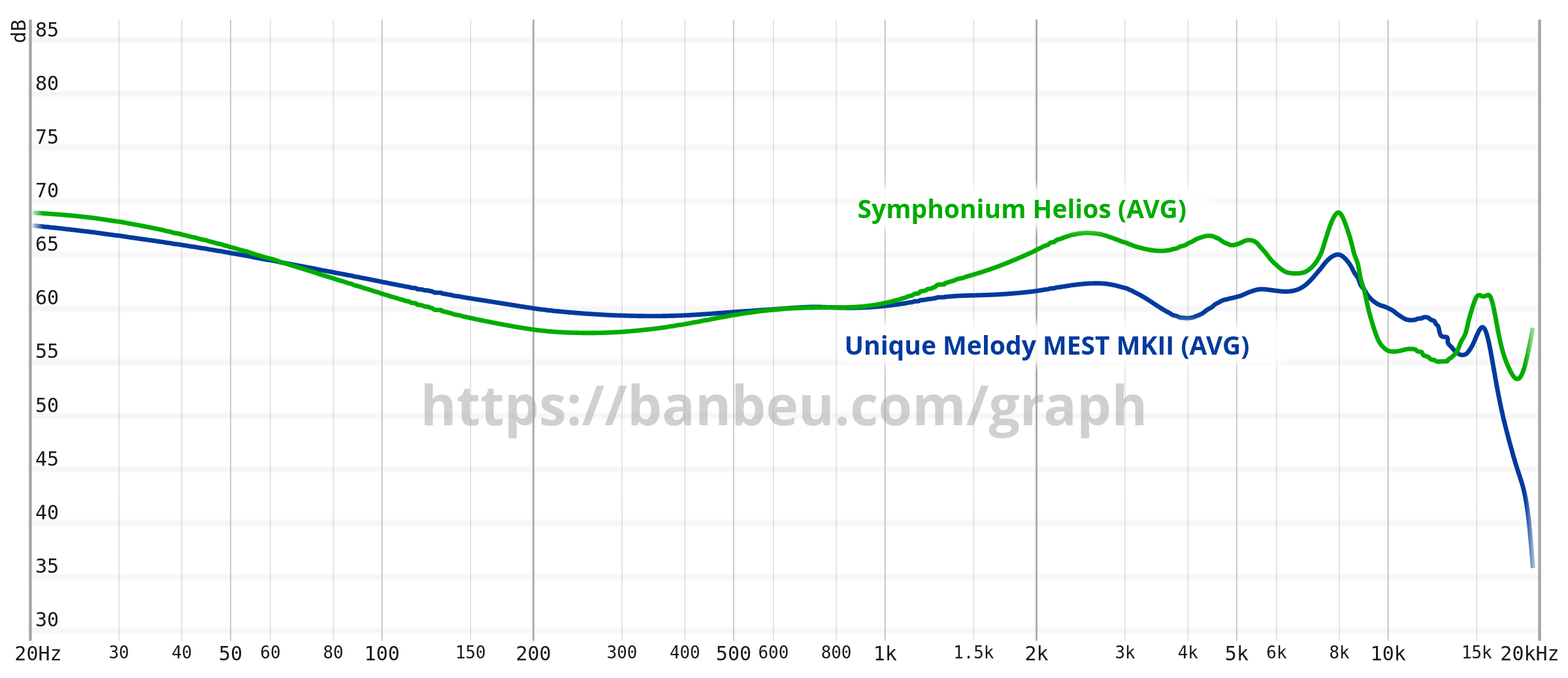
In hindsight, the MEST MKI might be more forward and exciting, but I want to make the comparison with the MEST MKII as the contrast between these two sets is clearer.
First and foremost though, one can consider from this graph alone that the Helios is more forward and has more bass punch, and for some of the parts, you are not wrong. Though to correlate this with my actual listening experience, I would say that the MKII is the slightly bassier one mainly due to my listening habit of cranking the volume if I found the ear-gain is lacking. This means with my desirable listening level for each IEM respectively, I perceived more bass with the MEST MKII.
That said, even if I normalize both of these IEM to the same level, or crank the volume up, it doesn't change how I see both Symphonium Helios and Unique Melody MEST MKII as two IEMs that can be regarded as the same rank in performance but for different reasons.
Of course, I would pick the Helios over the MEST MKII, cranking volume can do so much. The Helios treble is just something I absolutely enjoy despite some might have problems with it. Take the MEST MKII if you want a warmer, relaxed tone.Or in short, the Helios is the more exciting one while the MEST MKII is tamer one
vs Sony IER-Z1R:
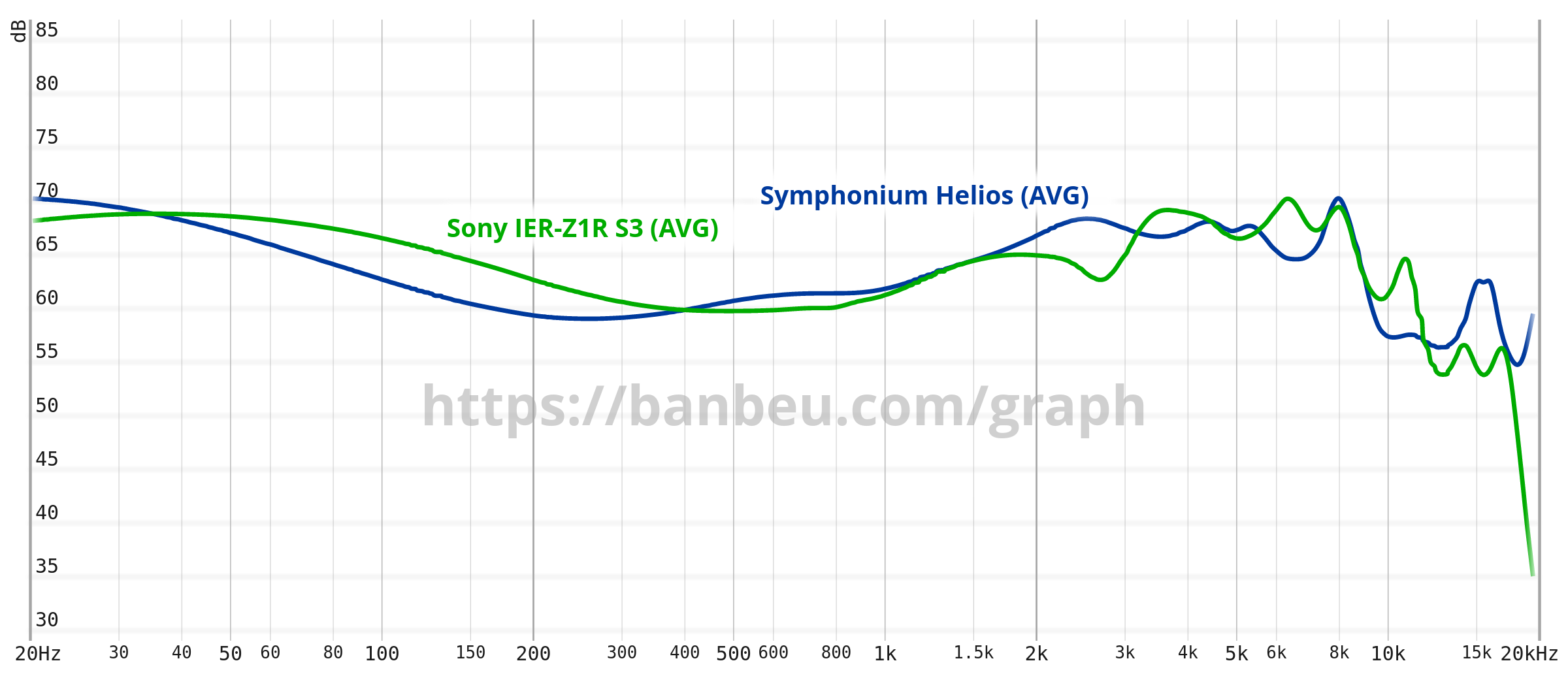
t's not that often that I bring the IER-Z1R into the conversation. But then, it is one of my favorite IEMs to the point I personally own a unit because of that.
I have mentioned that the Symphonium Helios and the Sony IER-Z1R are among my favorites in terms of treble performance, but how exactly, and which would I exactly choose?
To be frank, it's difficult to answer. At most, I would consider treble in the same caliber despite showing different traits. What they do share though is an amazing transient performance that gives both IEMs sparkles without going overboard. While the Helios "zingy" trait in its treble presentation might be more addicting to some, the Z1R makes up for it with its sheer, upfront treble presentation, which keeps the song energetic.
Ultimately, I would still pick the IER-Z1R over the Helios. This is even with my bold claim that the Helios is more resolving than the IER-Z1R; it just kicks the bucket when Staging and Imaging performance is mentioned. The IER-Z1R has a grand, diffuse presentation in its stage while keeping the instrument deadly precise. And details? It is still one of the top dogs in the market, despite might falling short of some similarly priced IEMs.
Of course, it is not an IER-Z1R comparison without mentioning its bass performance, but is that a fair comparison at this point? Maybe some of you can argue the Z1R bass is a bit bloated, but I have personally never seen it like that.
Anyhow, while I do have preferences on what is worth the price, both are amazing IEMs respectively. Of course, the Helios might have an advantage here when it comes to price, but what do you say? These are two kilobuck IEMs after all.
vs Moondrop S8:
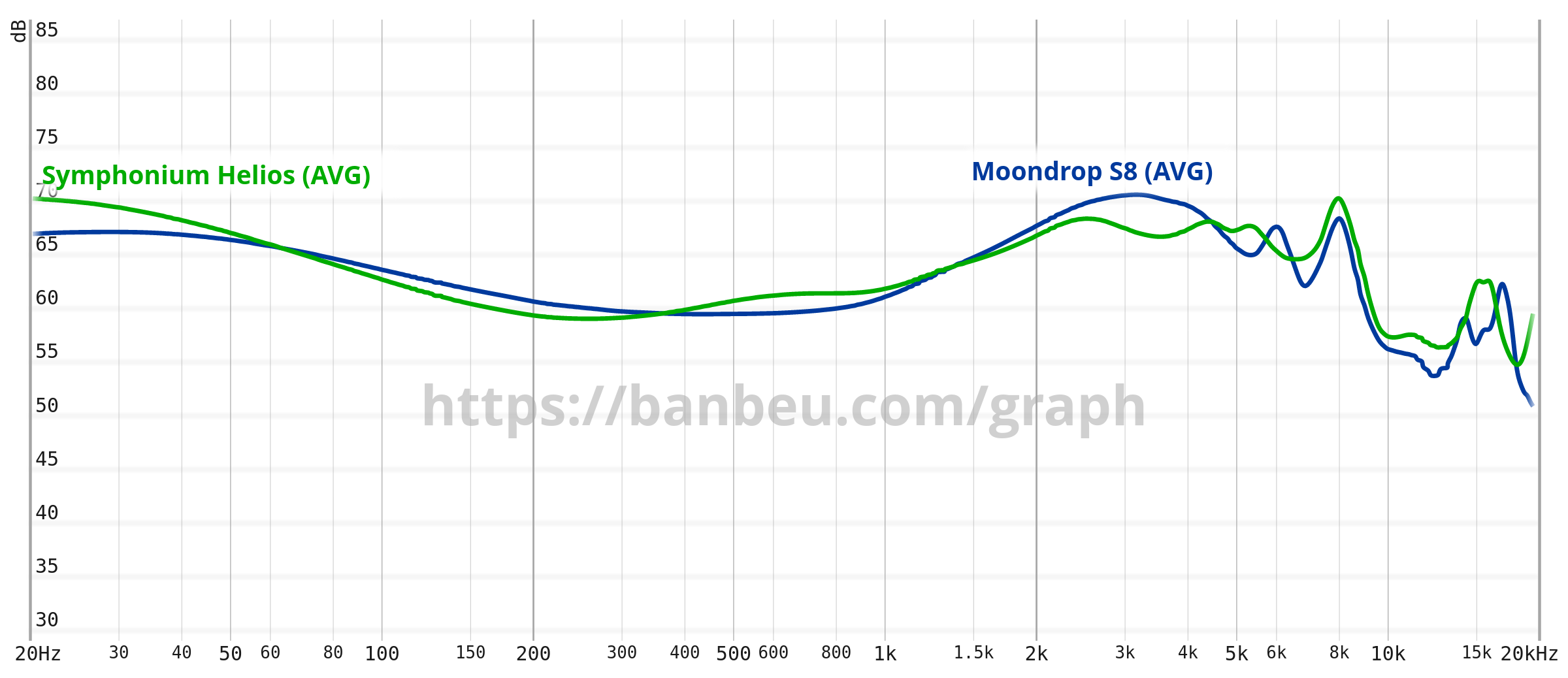
While both IEM are using a multi-BA setup, the Symphonium Helios just blows the Moondrop S8 out of the water for me thanks to its treble performance and its resolution.
I would still consider the Moondrop S8 to be a relatively safe IEM (Considering how I have been praising it, this doesn't need to explain much isn't it.
Staging/Imaging performance wise, I would consider both to be of the same caliber. As the S8 might have more accurate positioning, its stage doesn't have the depth and height as the Helios does. Though I reckon no one will care unless they are picky about positional cues.
Equalization:
based on the Banbeucmas Preference Target:Because I cannot miss an opportunity to mess with an IEM that has a treble response this good.
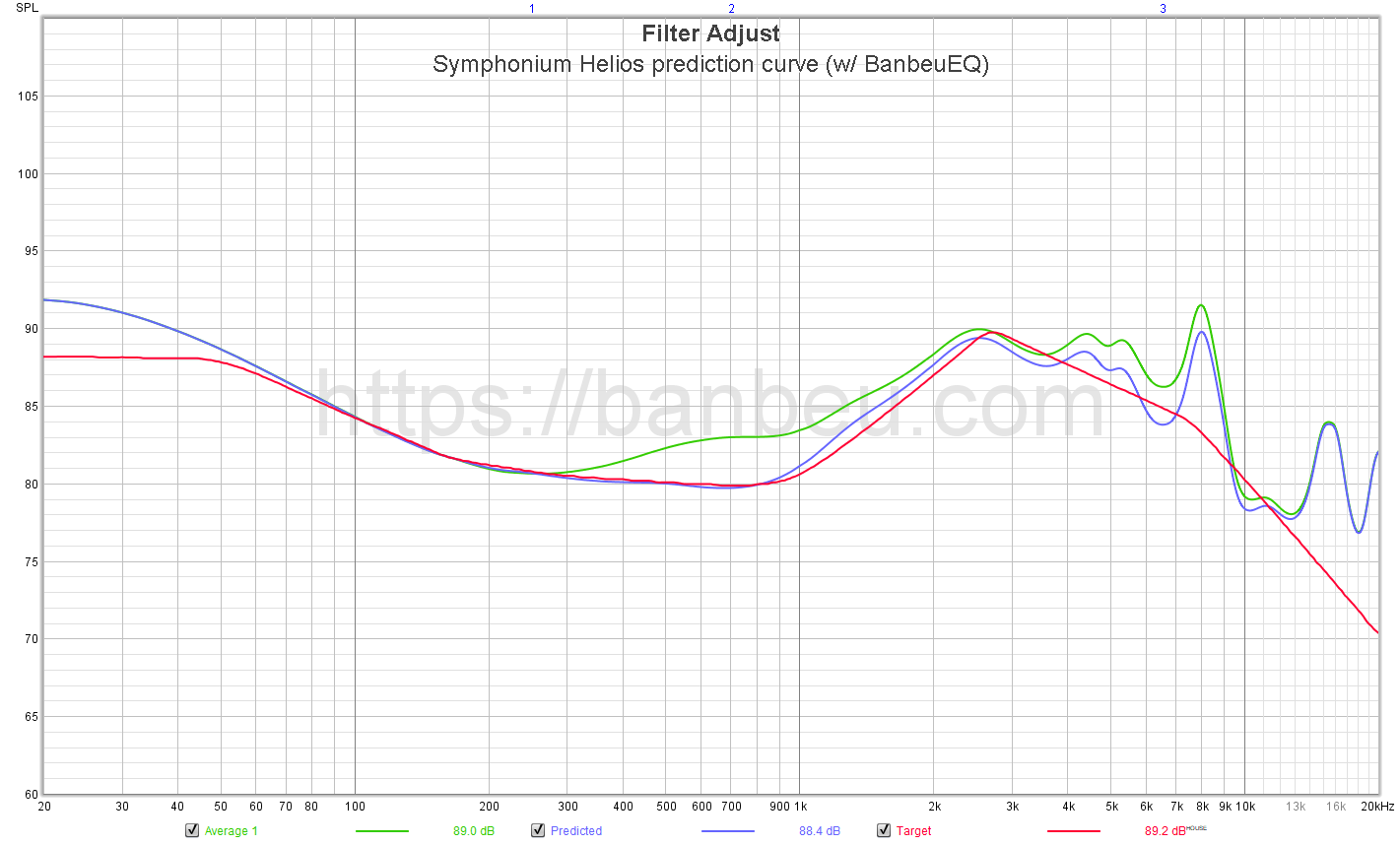
The most obvious equalization that I will do and surprisingly it's quite easy to do also. Most of all in this equalization I don't need to employ any Preamp gain. My preference target has always been trying to be neutral while keeping the sound engaging, and Helios' treble response is perfect for that. The only thing that doesn't line up here is the sub-bass; it's there to keep the integrity of the Helios along with its sparkly treble.Filter: Peaking; Frequency: 250Hz; Gain: +0.6dB; Q : 1.4
Filter: Peaking; Frequency: 700Hz; Gain: -3.3dB; Q : 0.9
Filter: Peaking; Frequency: 6500Hz; Gain: -2.4dB; Q : 1.3
Preamp gain: 0dB
What I am happy is with how minimal the EQ effort is needed for this to shine. This also allows me to keep my volume knob at a constant value without readjusting depending on the tracks as discussed in the analysis section.
I actually would prefer keeping the EQ up rather than the stock sound this time around. Quite a rare occasion considering every IEM that I use daily are with its stock sound (Except the Moondrop SSR).Be warned: This does actually made the Helios sounds a bit thinner due to my taste but might irks some users since the Helios is already "thin".
Other equalization suggestion(s):
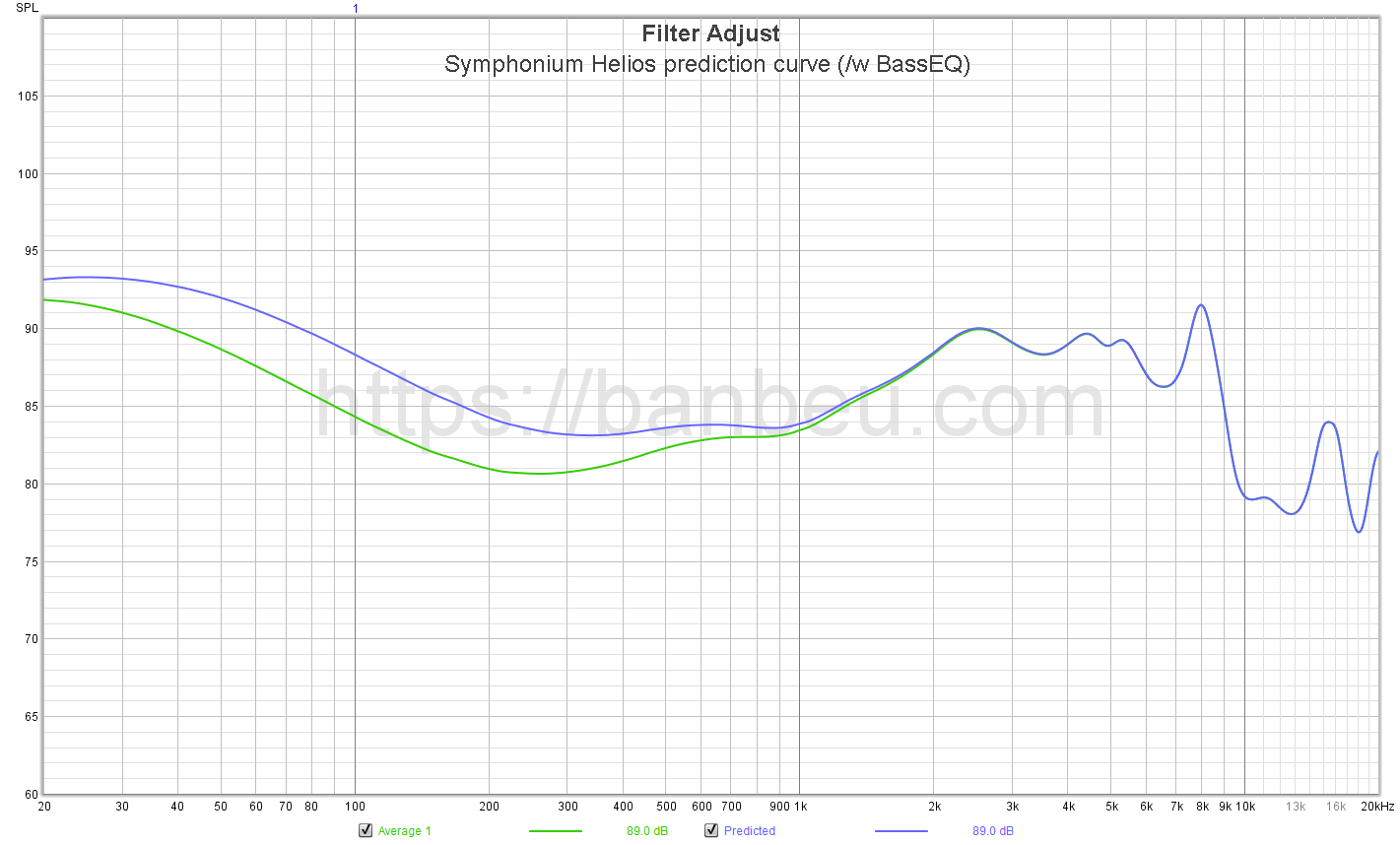
This one is a bit simpler, with the whole intention of trying to make the Helios bassier. This does make vocal sounds more recessed for my ears, though the goal is achieved to some extent.Filter: Peaking; Frequency: 100Hz; Gain: 4dB; Q : 0.3
Preamp gain: -4dB
Conclusion:
For an IEM that's at kilobuck price, the Helios sure doesn't disappoint. While it has its own flaws, it managed to nail a lot in my book while keeping itself as a decent contender in the market.But whether I am judging the Symphonium Helios with EQ or not (which I am not btw), it's an IEM that is priced right considering how the market goes.With EQ this is one of my favorite set that I use interchangbly with the IER-Z1R during my testing week.
Now, to the parents of this love child, I am looking forward to what you guys have in store, either separately or as a team.
Last edited:
Banbeucmas
100+ Head-Fier
Pros: Etymotic house sounds
A slight step up from the usual Etymotic in terms of staging
Good detail retrieval
Nice coherency
A slight step up from the usual Etymotic in terms of staging
Good detail retrieval
Nice coherency
Cons: Psuedo-custom shell... with a really long nozzle
BA Timbre is still apparent
Bass response isn't the best
Slightly honky
BA Timbre is still apparent
Bass response isn't the best
Slightly honky
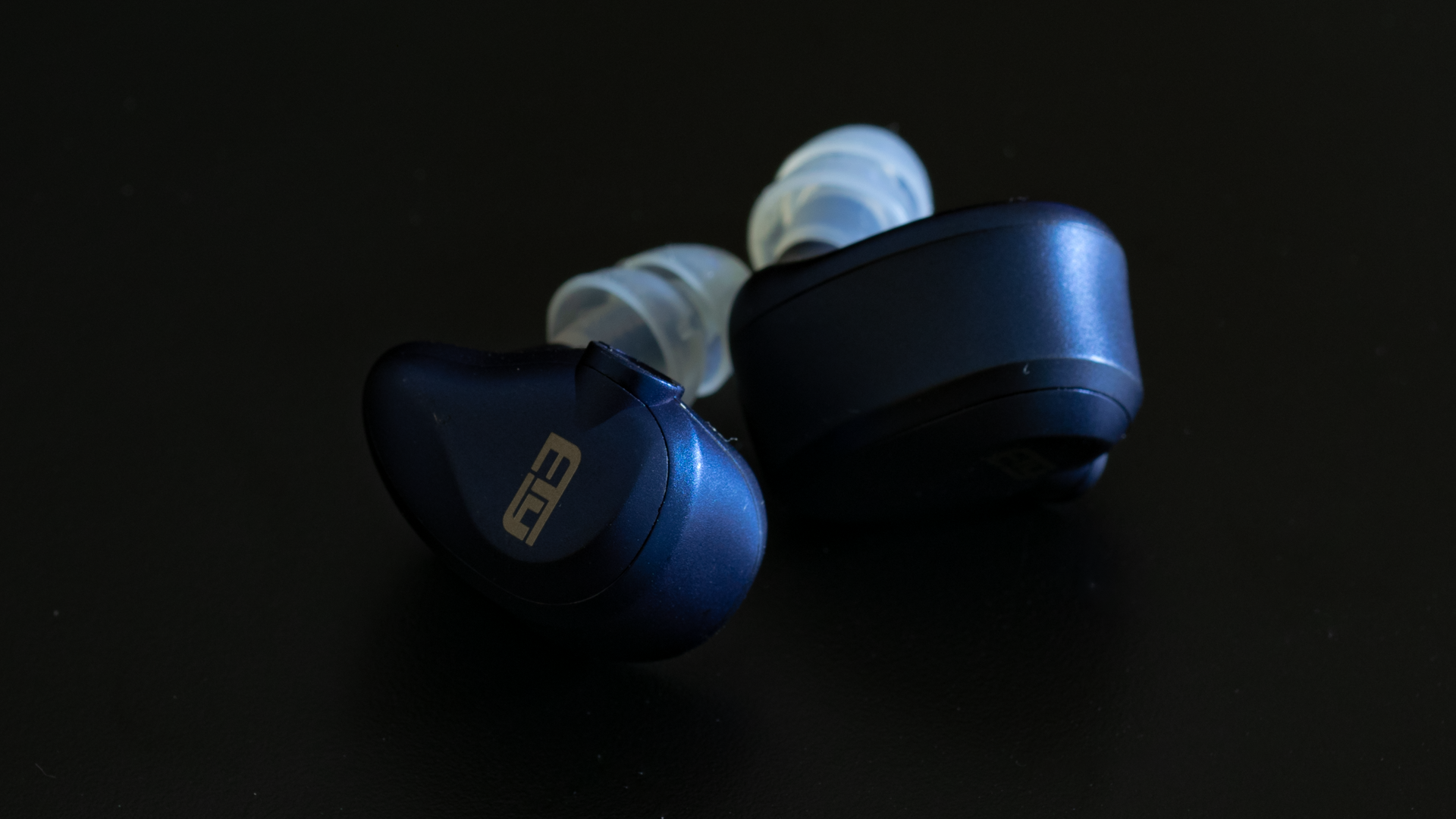
Etymotic, a brand whose age is nearly double the time that I spent on this earth. Though still relevant in the scene thanks to their iconic ER4 series as well as good audio quality. Personally, I own an ER4S in my collection and I know a handful of users (from the industry and enthusiastic scene alike) using Etymotic IEMs daily.This was unexpected coming from them. Though now that I think about it, this should have happened sooner or later.
Through the EVO release, it's quite clear how Etymotic is trying to achieve. A pseudo-custom IEM with Multi-BA setup. While these aren't new in the current scene where you would have people shoving as much as twenty-four BA drivers into a single shell. A company like Etymotic doing this for the first time does garner some attention.
Let's find out how far the first step of a respected veteran in the scene can go, shall we?
This review is a copy-paste from my blog, you can check it for more information: https://banbeu.com/etymotic-evo-review-classic-in-evolution/
Information:
- Drivers: 3BA
- Price: 499$
- Product information: https://www.etymotic.com/product/evo-multi-driver-earphone/
Build and Accessories:

- Double Flange tips (S/M/L/XL)
- Soft pouch
- Hard case
- 3.5mm unbalanced estron T2 Cable
- The IEM itself
Etymotic have been quite nice with the accessories set in recent days. The ER2XR, for example, is still quite solid in their packaging as a whole, not as flashy for sure, but everything provided does give you a decent to good experience compared to a lot of Chifi offerings.Disclaimer: The unit I received isn't a final packaging of the product. Be aware what you buy might be different from what I receive.
For the EVO, I do have a few concerns, however. Don't get me wrong; the case and pouch in this tour unit are quite nice. The former is quite solid, nice to hold, and they even have a premade foam placeholder for you to put the IEM in which is neat. The pouch itself has a nice texture on the surface while being large also.
But the cable? Oh boy, this is another story.
Usually, when it comes to cables, the worst I think can happen is one can provide something too thick or too heavy. But the Etymotic EVO is the opposite of that: It's thin and light in a very literal sense - the thing is thinner than almost any type of cable I have seen out of the box from an IEM package.
This does solve some of the problems people experiences, such as discomfort or the cable being prone to microphonic though in exchange for some newly created problem:
- When it's tangled, it's slightly harder to untangle: Yes, I won't deny that the cable itself has some stiffness so at least it's not gonna end up in some sort of mumbo jumbo when you try to pull it out. But, the thin cable does make it a bit troublesome when you actually have to untangle it.
- It looks so thin that one might worry it's going to break: Which might not be true despite how it looks, but still a concern, especially as it looks like a spaghetti noodle being stretched vertically.
Now moving to the EVO itself. Etymotic has been quite famous (or infamous, depending on who you ask) about their fitting. So this isn't a surprise.In any case whatsoever, don't take my entire word for it being MMCX or not, I haven't tested its compatibility with other MMCX cable I have in hand.
The EVO has all of the classic features you see in a typical Etymotic IEM but in a pseudo-custom shell. This can either be a blessing or a curse though I think people who have regular to big ears shouldn't have much of a concern.I mean... it's Etymotic... you don't see Etymotic without deep fitting the IEM into the bottom of your earhole abyss.
Though for people who have shallow earholes specifically... Let me provide an image of horror that can be some sort of amusement for you readers.
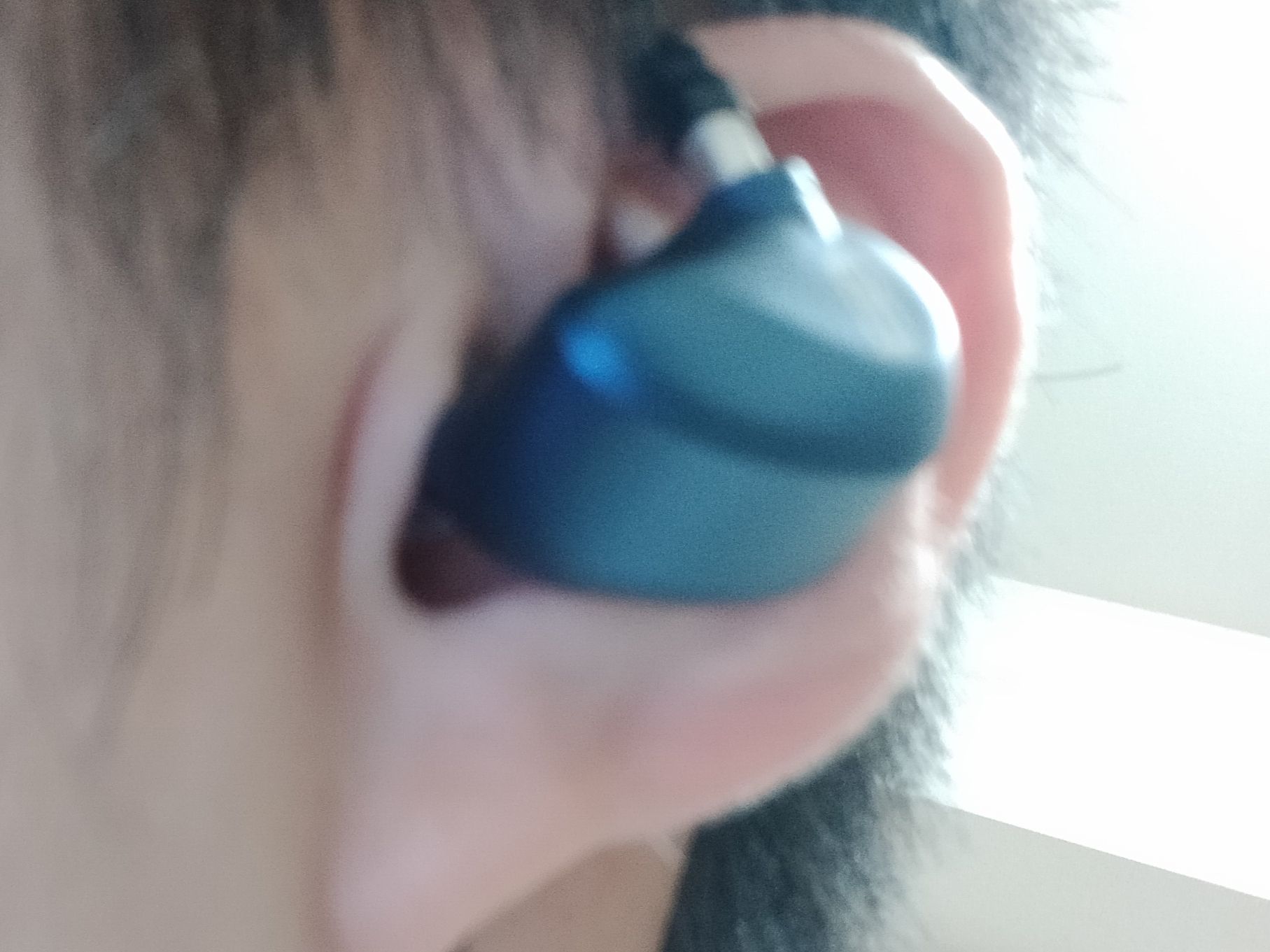
For your information, this is on the smallest double-flange ear tip which was provided. Yet the thing sticks out like how I wear an IER-Z1R. Moreover, I don't even feel any stretching sense on this IEM like other pseudo-custom IEMs. In other words, the nozzle was even longer than my ear canals themselves so much so the IEM refused to fit in my concha
Yes, yes, thanks for your own concern, I am good on this.Wait, do you actually have a seal on this?
The Etymotic fit lives up to its name by going to the depth of my ears and causing a lot of suction when I pull it out. This in turn, gave a better bass response and Etymotic level of Isolation, but the solid metal build does have its own problem. Due to its weight and how it is sticking out of my ear, weight distribution isn't the best. Hence, I have to tighten up the chin-slider tighter required compared to other IEMs (even the IER-Z1R don't get to this point) in hopes of it remaining in my ears while commuting.
So... take this experience how as you will though in a nutshell for people who have known about Etymotic for a while now.
This is still a classic Ety experience, don't you think?
Sound Analysis:
Since this is Etymotic we are talking about, it's quite obvious that the EVO will be tuned in accordance with their in-house Diffuse Field deviation. Though Warm Diffuse Field will be more accurate in this case considering the bass and lower-mid boost of this IEM.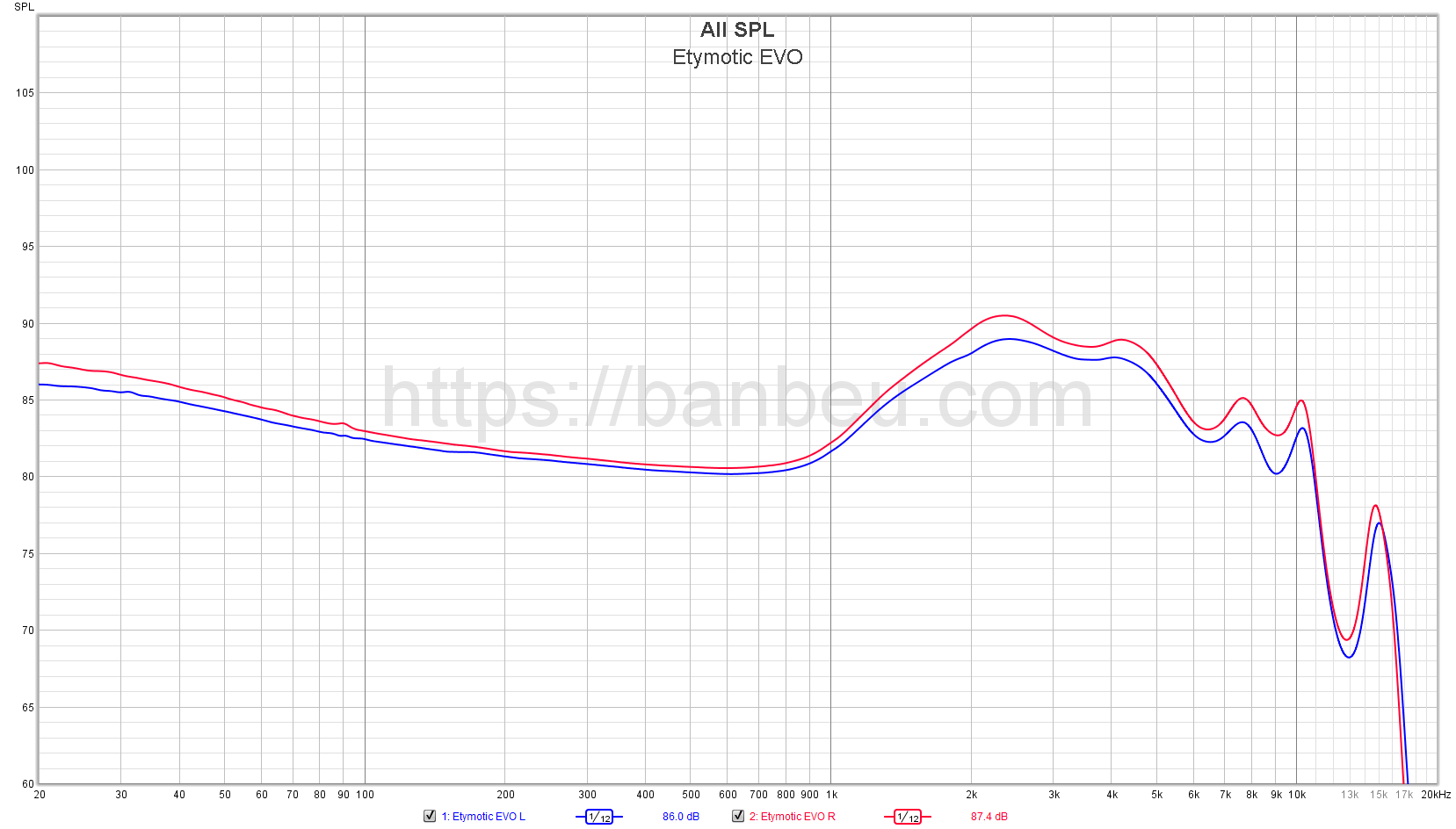
Tuning decision-wise, while no doubt Etymotic style is a charm to some objectivists out there, my preference is on the fence. It surely doesn't take long for me to get used to it for sure, but that slight honkiness does get mildly infuriating every time I tried an Etymotic IEM or any others that follow this methodology closely
EVO thankfully is quite warm, however. Hence, in terms of midrange, I am quite satisfied to recommend this set for someone who might like listening to female vocalists -
Put that aside though, the main attention of the EVO this time around is supplied on two fronts:
- It's the first major release of an Etymotic IEM in Psuedo-custom IEM form.
- It is also a multi-BA IEM.
Though the most positive aspect I can see out of the EVO is in its soundstage presentation. Yes, the isolation is still there, and the EVO won't get to a state of spaciousness like some of the sets I have ever tried. But this is way better than past Etymotic experiences thanks to the instrument layering. I am glad Etymotic has graduated from its classic staging experience.
That said, the applause stops here, here comes the mixed part.
Since we are still on the topic of the EVO's technicality, then let's move on to its timbre.
Given the traditions of Etymotic IEM BA sets' plasticky timbre, the EVO unfortunately (and expectedly) retains this characteristic. The whole sound spectrum seems to be coated with a sense of weightlessness thanks to the quick decay in the transients of the midrange and bass. Hence, this results in a sensation where you can notice the presence of the instruments but at the same time, cannot feel them.
Though in my opinion, the bass range is the most noticeable section thanks to this flaw. The bass is tight and quick for sure, but the impact is lacking a lot. Drums are the obvious victim of this characteristic. In a sense, a hit on the bass drum feels like the drummer is plucking a string instead (Yes, this is not a one-to-one comparison, but hopefully you can see where I am coming from). Sub-bass extension is not bad. While it's not the "deepest reaching" bass, the rumbles are there and can be quite satisfying thanks to the quick attack. Though, I will leave it to you readers to decide if this outweighs the flaws.
That said, be warned. This is far from an IEM that I would call as "at least acceptable" for bass-head. If I am recommending an Etymotic IEM based on this citeria, I might as well tell you to get the ER2XR instead.
Want to know more info? Read the comparison section then.
Treble on the EVO on the other hand is even more mixed. Saying it is dead would be too much criticism for it. Admittedly, there are surely some flaws, though I am not sure if I would necessarily call these "flaws".
Description-wise, the first apparent characteristic I have to mention is how dark the EVO treble is. While it does retain some sparkles when it comes to cymbal/hi-hat presentation, the shimmering does decay too fast for me, unfortunately. This makes the EVO not the ideal choice for J-Pop or energetic genres, though I would dub this more as passable.
Whatever it is, while not completely solving the issue, this thankfully made the EVO less "dry" sounding and made the experience less polarizing overall. It's even to the point where I would recommend the IEM for someone who wants a smooth and inoffensive experience. Might not be the best bet, but it's worth considering.
Comparisons:
vs Etymotic ER4S:
While a lot of companies have their ups and downs in terms of sound quality over time. With the age of the ER4S which has now been "replaced" by the ER4XR/SR, I won't be surprised if the EVO takes the crown here.
And in fact, to no one's surprise, it is. The EVO presented itself to have better imaging and delivered a timbre that is more organic in comparison. And if anything, the change in timbre qualities is more significant when moving from the ER4S to the EVO: Lots of instruments seemingly have more weight to them.
It goes without saying that I perceive the ER4S as the drier IEM. A couple of factors might be contributing to this. Maybe the EVO has more treble extension, maybe the EVO is warmer...
Every theory might hold true with how I have perceived the EVO here.
In addition, you can unironically call the EVO being the more technical IEM also. With respect to the resolution of both, the EVO simply just takes the cake here.
vs Etymotic ER2XR/SE:
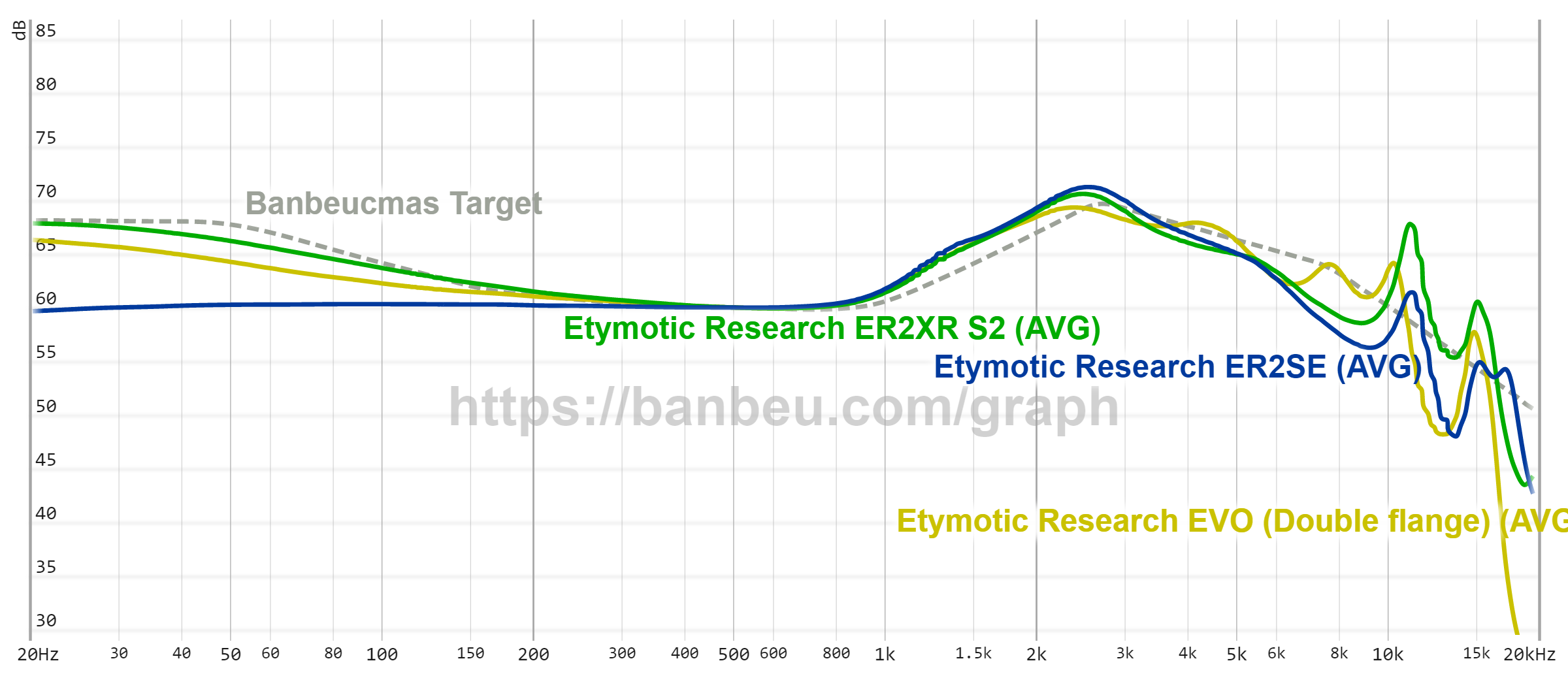
Here is a comparison that might be more realistic to someone who is using the review as a guide. After all, by the time of this writing, the ER2XR/SE is still one of the latest releases from Ety. And boi, getting these IEM during price drop sure is a treat for some.
Now, if I had to choose which one out of the ER2 pair has a closer experience to the EVO here, then it's a hard choice actually.
Yes, graph wise I would consider picking the ER2XR due to both having a noticeable bass boost, but here is the thing: I consider impact is a slightly different thing from just having a lot of SPL boost in certain frequencies. Though this doesn't entirely mean there is no correlation between the two.
If you have realized that the topic of timbre and transients is a recurring theme in this review, then you might have a clue of what I am going to say here.What does this mean exactly?
Despite the EVO having some boost in the bass, it feels as if there is none like the ER2SE is. At the very least, the SR do feel "fuller" if you want a linear response from the bass to the midrange, though the entire idea hasn't changed. Both provide less impact compared to the XR though for two different reasons. For the EVO, it's in the timbre of the bass range, for the SE, it just simply have more boost in the region.
Let's move into the midrange then. The ER2XR is warmer than the SR, and EVO is somewhat like that. Though with how the ER2XR performs, I would argue that it is the warmest (and bassiest) IEM in this comparison.Then, what's make deciding EVO and ER2XR made this a "hard choice" like you said above.
That said, this is as much as I can provide on individual differences. Both the 2SR and 2XR do have their own charm as 2 respectable DD pairs so for a user who is looking for an organic experience from Etymotic, these are the ones to go with. But for someone who is already an owner of one of these two and is looking for an upgrade.
Just make sure that you would trade the timbre performance for something that is more detailed, have better treble extensions, and better staging.
vs DUNU SA6:And possibly better fit, though if you read the build section above, I am not so sure of this claim :/
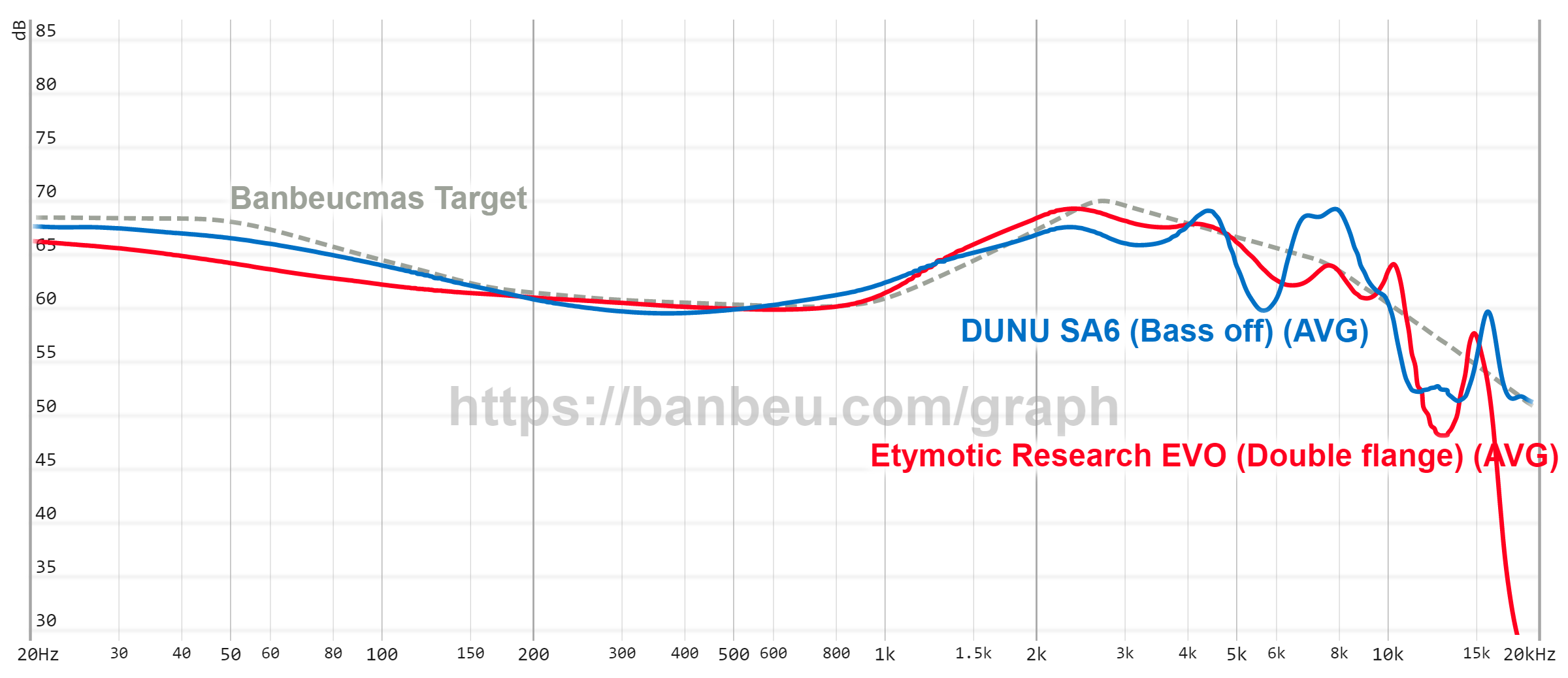
Ah yes, the SA6, if there is one IEM that DUNU has released recently that I have been recommending on and off, then this is the one.
For a pure BA configuration, the SA6 simply does a lot of rights: great coherency, a bass response that is unexpectedly good despite still having some BA characteristics.
Let's begin this comparison by me claiming that the SA6 has more "clarity" than the Etymotic EVO. Yes, the treble presentation of the SA6 is the reason here. It's quite upfront in the mid/low treble region thanks to the peaks around this range. Comparing that to the gradual roll-off of Etymotic EVO, not to mention that you would have to deep fit this anyway, it's a much more "pleasant" experience.Enough with that, let's get to the chase.
That said, I am not sure what to pick here actually. The SA6 bass response and clarity do support the idea of a better bet if you are looking for a fun, pure Multi-BA set that is also decent with its timbre response. The EVO, however, would fit for a neutral response with some small spices (like a bit of subbass boost) here and there. I would pick it for female vocalists also - it's just simply more forward and I get more enjoyment in this way.
Pick your poison, both are solid choices in my eyes. The best way I would recommend is that you should consider your music taste and pick one accordingly
vs Sony IER-M7:

This might be a bit unfair in terms of pricing if you consider that the M7 has been out of the market for a while. Though putting these two IEMs together, then I see some nice relationships between the two. Namely, both might be considered as unimpressive, though in different ways.
The EVO is unimpressive due to how nearly neutral it sound, now I do take a lot of joy out of a neutral (or nearly neutral) listening session, so this is more like a me problem, though Etymotic IEMs do have a handful of people calling their lineup "boring" in sound presentation. This isn't a bad thing in itself, just my observation overall.
The M7 though... The poor child usually gets neglected for something like the M9 (Or they go straight to Z1R) despite being a decent IEM on its own, guess that's how overshadowed it is. To put a nail in the coffin, my M7 impression is... boring.
No, not the type of boring because of deadly neutral or something, the M7 has a nice coloration in the midrange, with a treble zing of the end of the spectrum (It's actually well-executed actually). Though in all consideration, I just found the IEM lacks any "wow" factor for me. Still, a relatively safe option considering its price.
That said, if I am going to give my take on which IEM I might recommend more here, I would give it for the M7. It has better detail retrieval though it just put the EVO behind if we are mentioning its imaging. The timbre is also more pleasant to enjoy also.
Though in all fairness, there is some incoherency in the sound spectrum of the M7, the slight bloat doesn't help either so at least the EVO does have that as a leverage to the IER-M7.
Though if you look at another perspective, you can possibly treat the situation of the IER-M7 to the EVO like the DUNU SA6 is. Though the IER-M7 would be what I see as the safest option between the trio due to its pleasant sound representation (It's ironically would serve as a boring mix between SA6 and EVO now that I think about it).
Though in all honesty, every conversation I see that involves M7 often ends up with the IER-M9 or its flagship, though the liability of that should only lies in whether you really want to upgrade.
Praising much? Probably. The Sony IER-M7 just sounds underrated for me because of these reasons.
Conclusion:
The EVO marks the first time Etymotic actually went of their usual safe place in the Audio scene, while still keeping their own classic taste they have had over the year. Much to the pleasure and dismay of the fans, it's something that does have some tough competition nowadays but remains as a good IEM overall.I have no qualm about bringing this IEM into a conversation as the EVO itself, is a solid IEM.
But with the competition, I will (hold back) from fully recommending this IEM on a pure sound basis, especially since ER4XR/SR is still a thing (And might provide almost what the EVO has achieved).
Still, feel free to consider it as an upgrade from the usual Etymotic, it does have its justification of being better than the usual line-up overall.
Banbeucmas
100+ Head-Fier
Pros: Safe, smooth tuning that is based on Harman signature
Wide soundstage performance
A possible alternate consideration for people liking the KXXS, Starfield
Overall a safe recommendation for a lot of people
Wide soundstage performance
A possible alternate consideration for people liking the KXXS, Starfield
Overall a safe recommendation for a lot of people
Cons: Lack depth, slightly less accurate in positional cues comparing to its alternative
Cable quality
Not something for an overly technical listen
Cable quality
Not something for an overly technical listen

With how Moondrop advertises their product, I think a lot of Audio enthusiasts who happen to be Anime fans will know them. Though that wasn't the only reason why they have been gaining traction nowadays. Along the way, their product if anything has been gaining the reputation of being solid or above with IEMs like Moondrop Blessing 2 being hugely discussed in a lot of circles from my observation.
It seems like now Moondrop decided to revisit their old Aria model and gave them an update, though from the look of it the aria is more of an iteration of their popular KXXS/Starfield. Hence, to demonstrate its performance, I decided to make a comparative review this time around - let's see how it goes.
This review is a copy-paste from my blog, you can check it for more information: https://banbeu.com/moondrop-aria-2021-review-season-3/
Information:
- Drivers: 1DD
- Price: 80$
- Purchase link: https://hifigo.com/products/moondrop-aria-2
Build and Accessories:
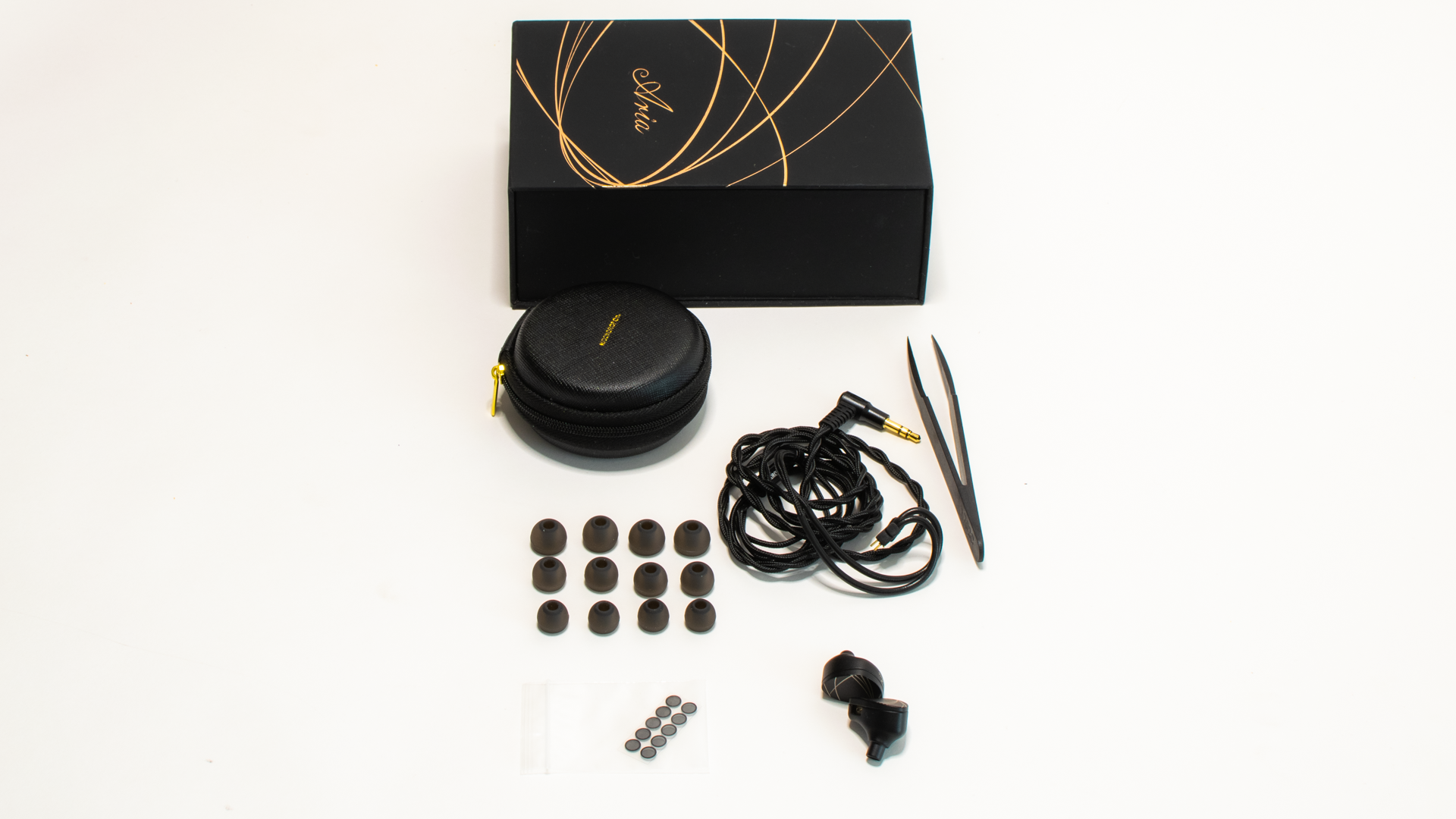
- 6 pairs of silicone ear tips (2 sets, each set consists of S/M/L size)
- Unbalanced 3.5mm 2-pin cable
- Storage case
- Tweezers
- 5 pairs of replacement filters
- Product instruction paper and company information cards
- The IEM itself
The cable is a hot mix between hate and love for me, the texture is nice for sure, but the plastic casing for the L-Shaped jack, Y-Splitter, and the 2-pin casing doesn't sit well with me. Another thing is that the cable is prone to tangling. All of this makes it arguably worse than the Shozy Form 1.1's cable which if you have ever read my review, would know that I really like.
Similar to its previous iteration, besides the black matted paint, the Aria doesn't have any change shape-wise except the backplate is now flatter. A smaller change one can notice is the filter of the Aria seem to be slightly different, with the holes arranging in a Hexagon-shaped position.
But, that's all I can say
Sound:
Aria and the KXXS line-up:

Graph are measured with an IEC-711 Taobao coupler. Check the Graph comparison tool on my website to make comparison with various target curves and IEM by clicking here
If you are familiar with Moondrop product, you can skip this already, but for people who are new to the brand and doesn't know anything about their "KXXS lineup" signature, let me fill you in: These IEMs essentially follows what I would consider as a "Harman signature", though admittedly have tamer pinna gain along with a warmer lower-mid but other aspects like how the gain is formed to the similar level of raise in the bass shelf (and of course, coming from my auditory experience) do make its signature to be considered like so.
Note that this is far from what I would call a "True Harman" signature and on another note, it can be plausible that one can call the Aria signature as "Mild V-Shaped", though I digress.
Pretty much due to the target that these IEM are based on and the alternation done in the Frequency Response domain, I can consider their tuning as "safe". It's a signature type that is energetic enough without going overboard. Copping this with their technical performance (which I will address below), this generally is a decent choice in my recommendation list especially for someone who is still clueless about their desired tonal presentation.What does this mean then?
Well, knowing Moondrop marketing strategies and tuning tactics this should not come as a surprise anymore, the Moondrop Aria essentially inherits the KXXS and the Starfield tonality, follow closely to the point that the frequency of these three IEM looks almost identical on paper, one can even think this was just a case of unit variance.So, why that lengthy wording about the "Harman signature" stuff? What is "KXXS line-up"?
Hence, for someone who has been disliking the KXXS and Starfield sound signature, the Aria is unfortunately still a pass, but for someone who wants to know if there is any change (even how small it is or not), read on.
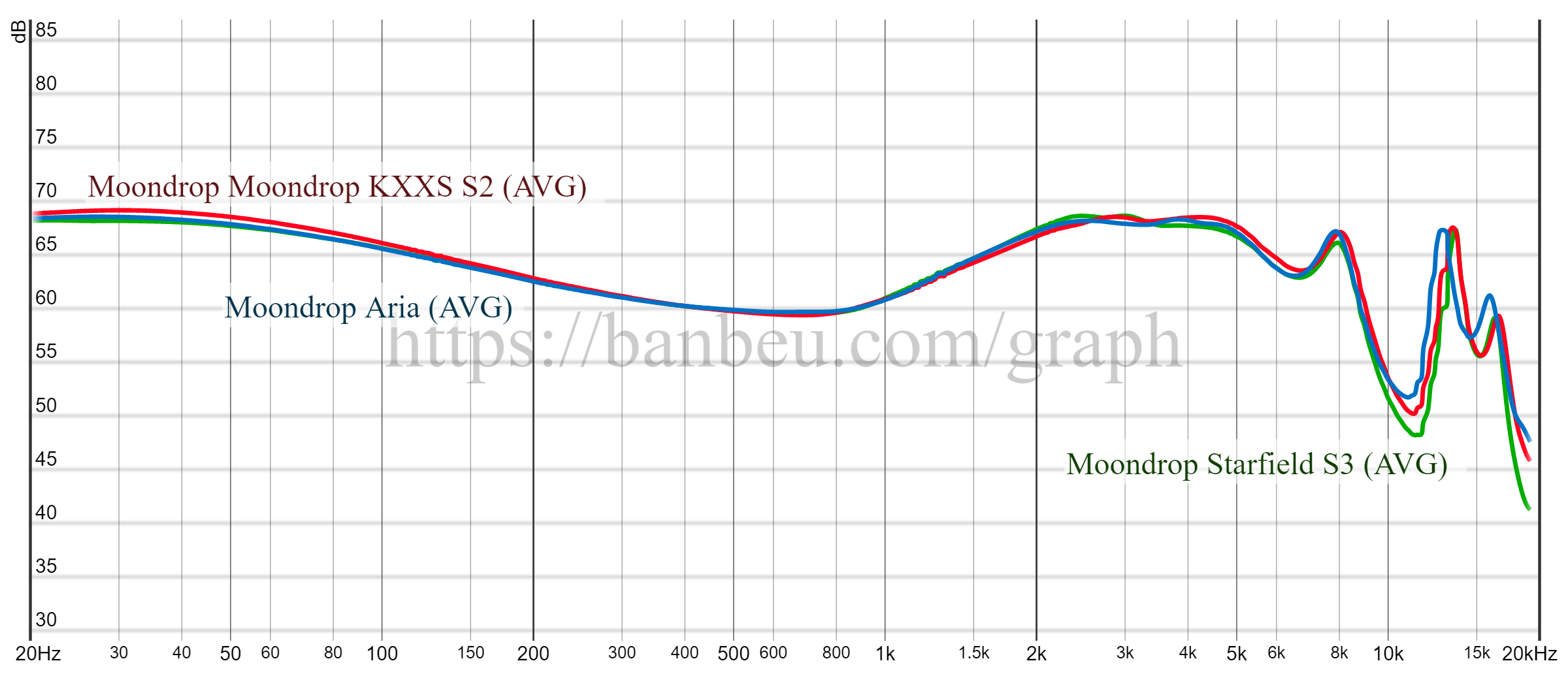
Now, I know there is still one more person in the family here which I haven't heard myself which is the KXXX (throw the Kanas in also if you consider it as a member of the series) but at least, at the tonality level, the Aria can be mistaken as the KXXS and Starfield respectively. In all fairness, without actually A/Bing three of them together, I won't realize that the Aria being the warmest IEM from the three. "Gladly" though, thanks to its technicality, the Aria price difference from the Starfield do make a bit of sense.
Yes, there are some small notable differences in this chamber this time around: the Aria has a wider soundstage, even among the IEM that I have experienced it gets surprisingly wide in comparisons, but lacking the depth in terms of layering. Instruments do sounds smeared together quite often hence this won't be my pick when it comes to Orchestral or Instrumental. I would even take the Starfield over this due to how more accurate the instruments are placed in the sound field than the Aria. Though, an appreciated factor that can make people pick the Aria over is that the bass response is slightly tighter.
Other than that, nothing out of ordinary. The Aria (and the whole KXXS lineup imho) is one smooth of an IEM texturing-wise. It admittedly has enough to separate them out of the sets in the sub-100$ range, but over that to the 300$ mark, detailing is just bland in comparison.
Though just to be more specific: Aria < Starfield < KXXS in terms of texture and details. Though honestly, all three aren't that far off with each other to justify them being in their own "league" respectively.
Choice comparison:
vs Etymotic Research ER2XR: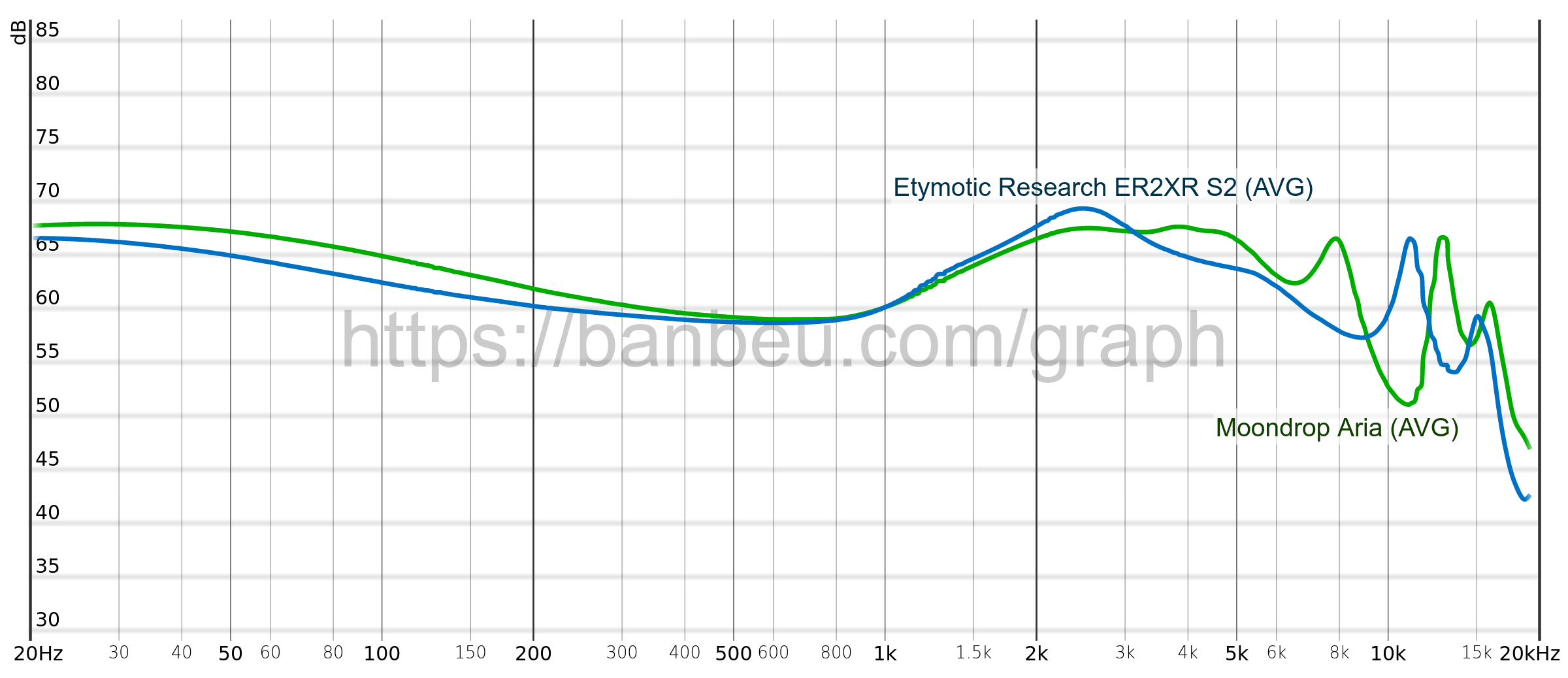
Considering how I have referred the Aria to the Starfield in the above section. Some can guess out already if they have read through my Moondrop Starfield vs Etymotic ER2XR comparison in my ER2XR review.
The situation here while goes in a slightly different way, still ended up having identical results in a lot of points, basically:
- The Aria has better soundstage than the ER2XR (Wider rather than deeper), just like how the Starfield is.
- The Aria has worse detail retrieval than the ER2XR, just like how the Starfield is.
- The Aria has slightly worse treble than the ER2XR, just like how the Starfield is.
Now, if we bring the price department into consideration, the ER2XR is commonly at least 30$ pricier than the Aria. But then again, this piece of Etymotic work also has several occasions where it went as cheap as 50$ since its release already.
If you can wait, wait, else the Aria is still a solid choice,
vs Tin Hifi T2+:

I don't mention the Tin Hifi T2+ much these days, but it's still one of the few solid IEM in the sub 100$ bracket nowadays.
Now despite how the graph is suggesting that the Aria can potentially shoutier than the T2+, my auditory experience was a bit different, namely the Tin Hifi offering often come out as more forward and more nasally with some of my usual test vocals like Mitsuki Nakae, Mameko... comparing to the Aria. This also is one of the case where I think most of this perception was significantly due to how early the raise was rather than just having a bigger SPL.
The Tin Hifi T2+ overall offers a thicker note weight with a warmer tone in relative. This would have been what I consider as a "more pleasing" presentation until the lower treble spike at ~5.5kHz kicks in before rolling off, giving a sharp, dry sensation that might come out as offensive to some ears. Moreover, the T2+ does sound more narrow in terms of positional cues comparing to the Aria, though it has a bit more depth to compensate for this.
Conclusion:
I will admit, I have a bit of trouble writing this review in my normal format, mainly due to how similar the Aria to its sibling. A lot of comparisons, reference to be made with the past model if anything, would have similar results with the Aria also.That's precisely why I would recommend the Aria giving the fact that I have recommended the Starfield before. At least, the justification with the down price this time is that the Aria (imho) is arguably worse than the Starfield due to its imaging performance. Can't think of a way to blame Moondrop though, slapping a response and trying to improve the technicalities has always been their thing.
Not sure about how it will go in the future, but if this goes on, hopefully, the KXXS series will achieve the true chunk of gold it is trying to search for.
Last edited:
4
430633
Interesting to see you've got 5 pairs of replacement filters- only 3 came with my set
Banbeucmas
I have no idea with that actually lol
Banbeucmas
100+ Head-Fier
Pros: Warm, pleasant signature
Decent upper treble boost which creates an airy sensation
Bass has good slam and texture
Detailed lower midrange
Competitive technical performance
Decent upper treble boost which creates an airy sensation
Bass has good slam and texture
Detailed lower midrange
Competitive technical performance
Cons: Average imaging and soundstage
Fit might be an issue
Airy for sure, but might be a little bit zingy
Fit might be an issue
Airy for sure, but might be a little bit zingy

Despite being quite popular in Japan, Acoustune doesn't have that much reputation in the Vietnamese community. That doesn't come as a surprise though, since I understand that there are more risks for local storefront introducing this brand into the market, hence demoing sources are sacred.
Though, since the beginning of this year, I have moved to Japan for personal study so I decided to try out the brand just to see how it goes. Hence, I bought the Acoustune HS1300SS since it's a recent release (at the time of this writing) and also it's affordable with my money. Let's see how it goes
This review is a copy-paste from my blog, you can check it for more information: https://banbeu.com/acoustune-hs1300ss-review-correctly-colored/
Information:
- Driver: 1DD
- Price: 300$
- Purchase link: https://www.e-earphone.jp/products/detail/1304097/
Build and Accessories:
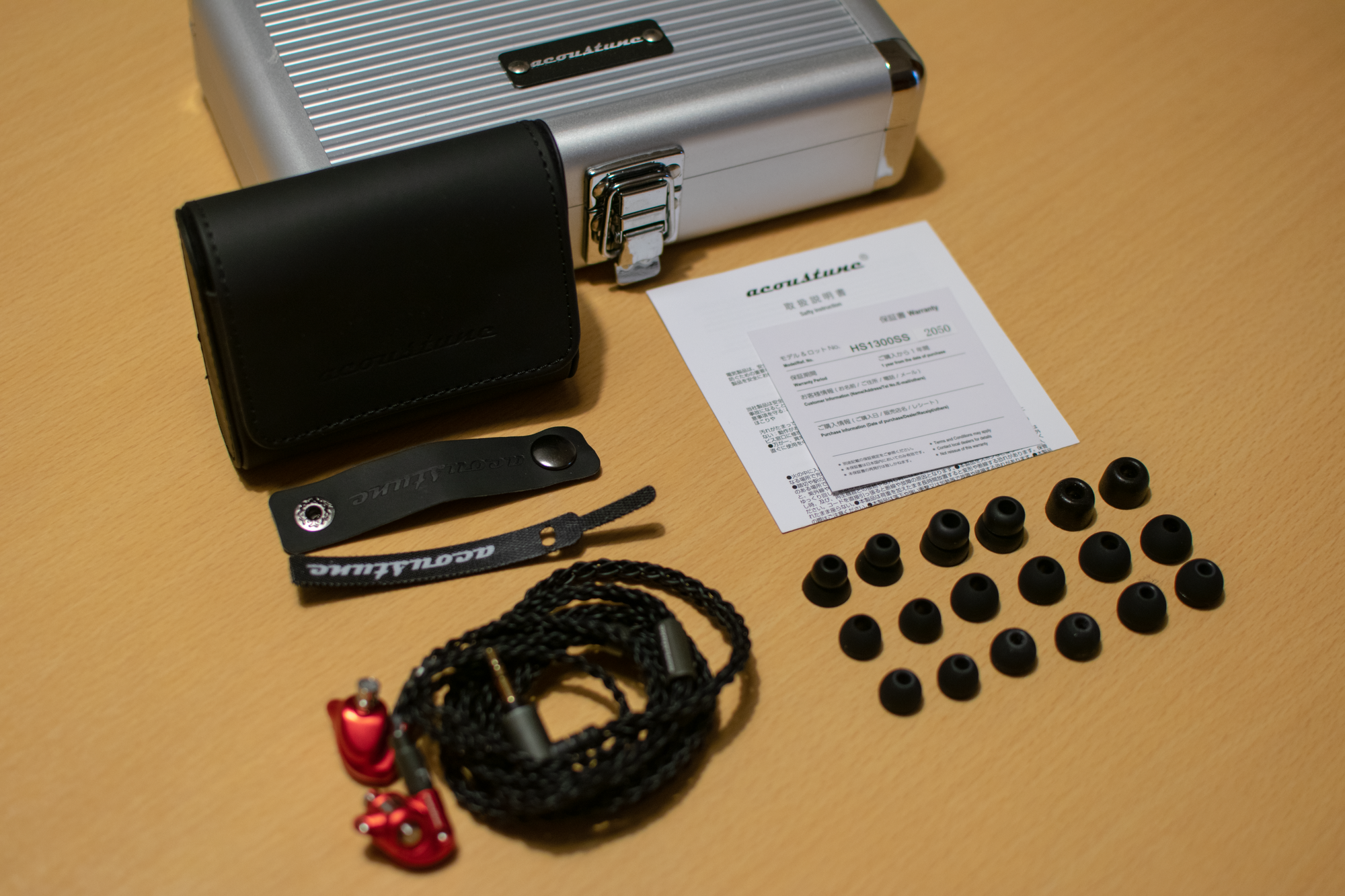
- 3 pairs of Acoustune AET07 tips (S/M/L)
- 3 pairs of Acoustune AET08 tips (S/M/L)
- 2 pairs of Acoustune AET06 tips (S/M)
- 1 pair of Acoustune AET02 foam tips
- Warranty card/Instruction paper
- 2 cable tighteners
- 1 Soft case
- 1 IEM briefcase
- Unbalanced 3.5mm cable with proprietary PentaconnEar connection
- The IEM itself
Regardless, I find myself satisfied with the HS1300 accessories. The soft-case is ok: it's nice to hold but I feel like the lid is too flexible, if it is a little bit harder then it would be nicer to use. The cable has some rubbery texture which isn't something that I prefer. Though, I really like Acoustune proprietary connection here, it's easy to apply the cable to the IEM as well as taking it out, the connections are tight which leave me with no problem in using it. That said, this would hinder a lot in terms of finding replacement cables since it is not following the usual standard like MMCX or 2-pin which is plenty in the market nowadays.
That said, the Acoustune HS1300SS features a unique design with a stainless steel frame and cylinder chamber inside. It's a weird design where weird edges are sticking, posing concern in terms of comfort. Since my ear canal is short and my pinna is flat, I don't have trouble fitting it. But, when I asked my friend (who has bigger ears) to try it, he said one of the edges of the HS1300 touched his ear, causing discomfort after 30 - 45 minutes of wearing.
Others who happen to buy the IEM around the time I got it reported that they are fine with the fit (with one claiming it is one of the most comfortable IEM they have tried). So it boils down to how sensitive your ears are and the shape of them.
Caveat emptor if you are planning to buy the HS1300SS, I highly recommend you to make sure that you are comfortable with the fit before buying.
Sound:
Tonality:
The Acoustune HS1300 SS has a "Warm V-Shaped" signature which is evident by the bass/midrange boost and the upper-mid + treble focus.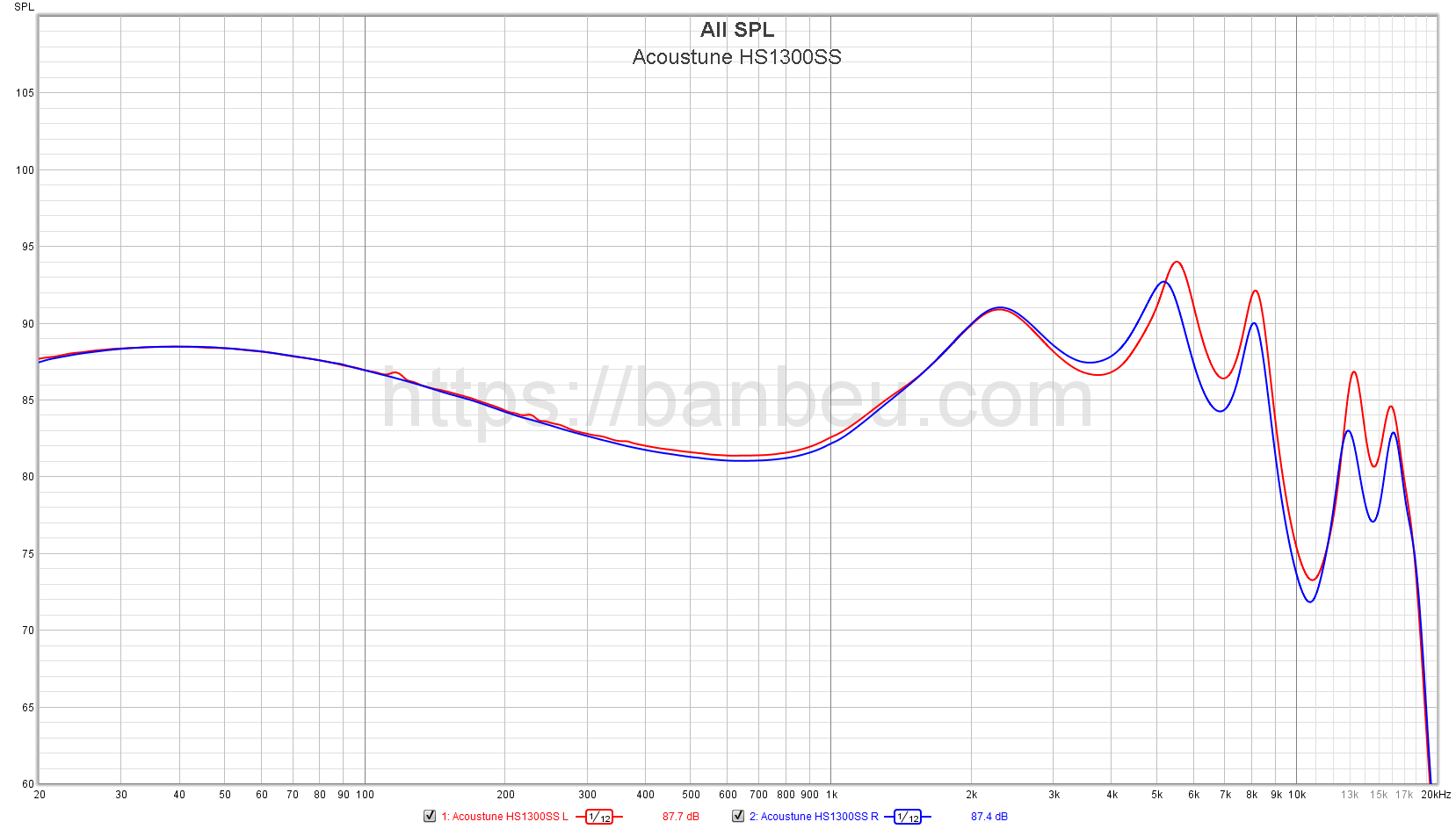
Scanning through the frequency response and you can see some possible explanations:
- The pinna raise at ~2.2kHz
- The ~5dB peak at ~5kHz
On top of it, the HS1300 also has decent upper-treble boost which results in an airy presentation in a lot of track that I throw it into. This would be what I considered as a pro in this IEM if not for one thing: The 13kHz peak.
Yes, I know that I always said that graphs over 10kHz are not to be trusted hence I have to use sine sweep to confirm this on my own. This results in a sound presentation that is slightly zingy when it comes to instruments like cymbals and acoustic guitars... Some vocal recordings do show this too, for example, Mameko's vocal in Mamyukka - 深海図鑑 or Aitsuki Nakuru's in AcuticNotes - Sherras...
That said, I am not someone who particularly too sensitive about it unless it is something like the Tin Hifi P1 (and P2), not to mention you would only pick this up in some "badly mastered" recordings anyway. What irks me more in terms of vocals presentation is that it can often come out as slightly shouty and nasally to my ears. Hence, it won't be my utmost pick when it comes to J-Pop (or K-Pop) when it comes to recommendation unless you can forgo this issue.
Technical performance:
While it won't be the top performer in the price bracket that it belongs to. The HS1300 is still quite competitive. Most notable to me is the lower midrange, where the IEM managed to provide good transient and detailing. The bass is decent too, a bit bloat to my ear but overall providing good slam and texture.That aside, what tanks this IEM down is in its average imaging and soundstage. Instrument layering on the HS1300 lacks some depth, the soundstage is still contained rather than having an "over the ear" sensation. Not only that, there are also some sense of the notes smearing into each other which hinders its resolution by a bit.
Though, it's definitely better than a lot of IEM I have listened in this regard. And not really a surprise regarding imaging/soundstage since not a lot of IEMs can achieve this anyway.
Choice comparisons:
vs Moondrop Blessing 2:
People might feel this comparison unfair considering Moondrop Blessing 2's reputation in its sound performance but I reckon a lot of people reading this article will have this IEM (or at least have heard about it a lot) so it's a good reference point.
That said, no sugar coating here, the Blessing 2 trumps the HS1300 in any way imaginable in terms of technical performances. Wider soundstage and better in terms of instrumental position accuracy. Detail retrievals is even out of the question.
Were if there is anything that giving the HS1300SS the edge over. It would be its colored presentation that can be appealing to some people. Not only that, it has better bass performance - more quantity and better texturing. HS1300SS also has thicker notes, which can be one of the factors that you would consider over the Blessing 2.
vs DUNU DK-3001 Pro:
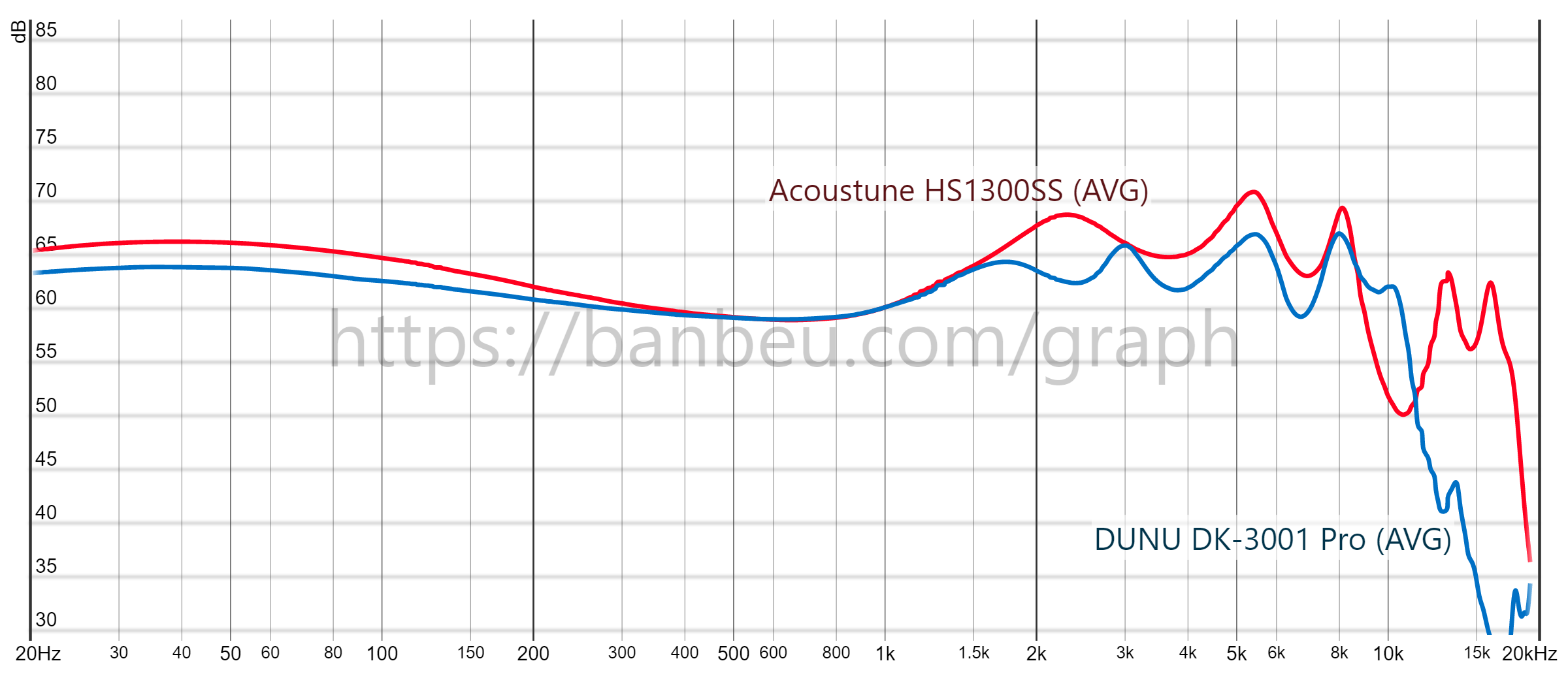
With the Moondrop Blessing 2 as the benchmark for my recommendation in this price range, the DUNU DK-3001 Pro usually served as one of my alternate recommendations were if one doesn't like Blessing 2's tonal performance.
Hence, I put these on comparison because I feel HS1300 deserves the same spot as the DK-3001 Pro.
Comparison wise, DK-3001 Pro flash out trumps HS1300 on bass transient, a little bit better in terms of detail retrievals and on top of it all, is a more balanced tuning. Yet, the HS1300 is more colored, airier and has more bass quantity - it is more engaging to listen to.
And then when I think about the similarities: The sharp lower-treble, average imaging... Then the HS1300 sounds like the opposite side of the same coin with the DK-3001 Pro - it fills in what the DK-3001 doesn't have with some small sacrifice in resolutions.
Of course, in terms of pricing, one could say that the HS1300 will be better for your wallet and I would not argue. Though, if I were to have a ranking page like a lot of people have nowadays, I would put the HS1300 at the same spot as the DK-3001 for these reasons.
vs DUNU DM-480:

Anyway, it's not hard to understand the reason why if you are familiar with graphs. While both have similar tuning style, the HS1300SS is more balanced than the DM-480 by having less aggressive mid and less bass quantity - resulting in less bloat.
That said, what is on the graph isn't always reflected when it comes to subjective impression, so, what about it? Resolution wise, the HS1300's note decay is more natural, better detail retrieval, airier, soundstage is more open than the DM-480...
Overall, just better sound quality which is not a surprise considering the price difference. But still, the reason why I dubbed this as "upgrade recommendation" comes from the tuning style of both which are similar to each other: throwing any instruments that I am familiar with from the DM-480 to the HS1300, then I will find the latter presenting it similarly, albeit with some improvements.
Conclusion:
All in all, the Acoustune HS1300SS is not something that one would find it amazing in this price bracket like the Moondrop Blessing 2, nor it is a "jack of all trade, master of none" due to its colored signature. But, it has decent technical technicalities to back it up and a tuning that not just doesn't break the bank, but also has some of its own twists without going too far.Hence, I will give it my recommendation. Quite a unique IEM that I got the chance to try once in a while
 .
.Banbeucmas
100+ Head-Fier
Pros: Good clarity
Balanced sounds comparing to T2/T3
Good packaging
Technical ability is amazing for the price range
Balanced sounds comparing to T2/T3
Good packaging
Technical ability is amazing for the price range
Cons: Lack bass
Shouty upper mids
Average imaging and soundstage
Shouty upper mids
Average imaging and soundstage

About me:
I am a student who loves to talk and write about everything I made and found. Music/Audio happens to be one of them as I listen to music daily and play some Piano/Guitar along the way. My music preference is Rock, J-pop and especially Instrumental, I do listen to other genre of music if I happen to enjoy the song provided.
The review is from my website: https://banbeu.com/tin-hifi-t4-review/ with some editing to fit the time I am writing.
Introduction:
Tin Hifi, despite my dissatisfaction with the P1, they still seem generating new hypes every time they release a new product. The Tin Hifi T4 is no exception, with tons of positive reviews from reviewers who received the product early just to "tease" their audiences and more or so with a successful crowdfunding campaign of over 300.000$ on Indiegogo, no doubt it is one of the hype of the chifi community in the last quarter of 2019. So, while most of the reviews out there are far before the release of the earphone itself, this post will be one of the first reviews of the Tin Hifi T4 after its release to the public, reflecting my own experience with it after a few days using it.
Informations:
- Price: 110$
- Drivers: 1 DD
You can purchase the Tin Hifi T4 on linsoul website after a few days.
Packaging and Builds
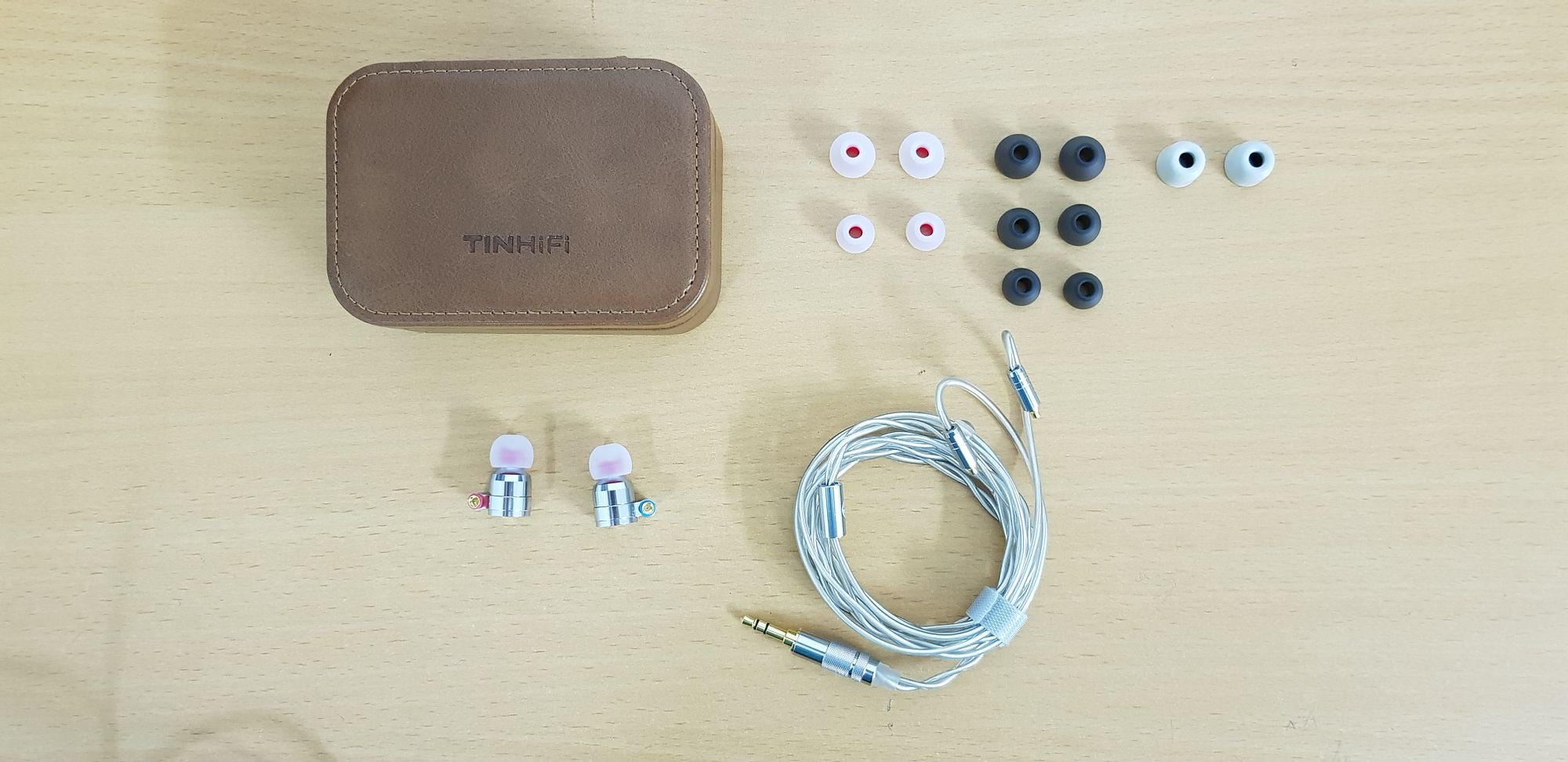
- 3 pairs of white silicon tips (S/M/L)
- 3 pairs of black silicon tips (S/M/L)
- Pair of foam tips
- 1 leather case
- 3.5mm unbalanced MMCX cable (Which Tin Hifi also claim to have a market value of 35$)
- The IEM itself
The Tin Hifi T4's build is metal as usual, but the coating is different from T3 and T2, there is also a new jet-engine like pattern on the back plate also. For some reason, the earphone has actually shocked me several times when I tried to use it with my laptop, something which hasn't happened to me when I tried their past product. While this issue is common for metal IEMs, I will give out this warning for the first time to future Tin Hifi buyers. (Or at least, ground your house...)
Sound:
Signature & Measurement:
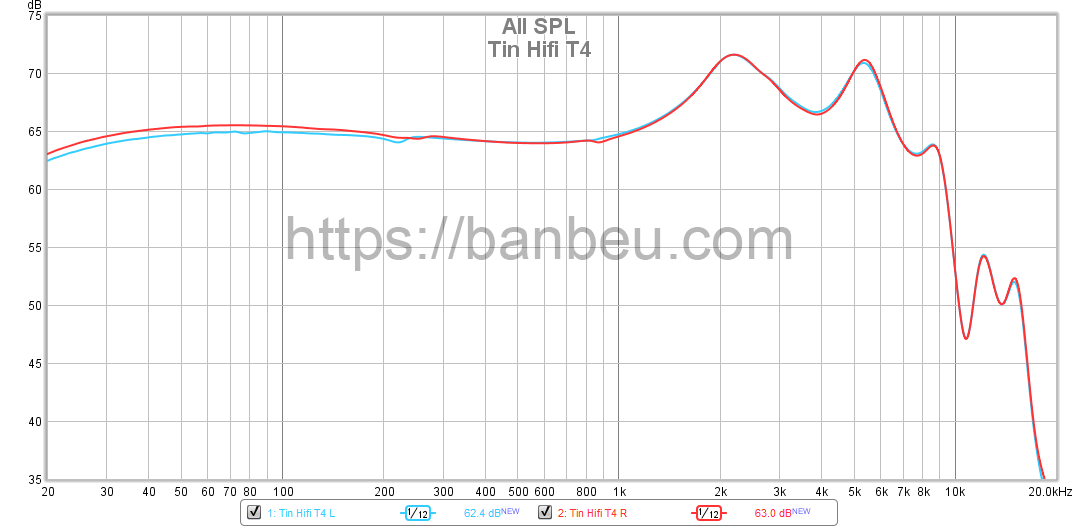
Measurements are done on a steel coupler with dynamic microphone, while the result seem to be close to an IEC 711 coupler, there are noticeable roll off in the bass region and frequencies higher than 10kHz is also expected to have roll off.
The T4 seem to follow a neutral bright signature from its predecessor, but I have seen different interpretations of it: mildly V-shaped, U-Shaped, some even would even say it is warm-neutral. But, I think it still can be called as a neutral IEM despite the tuning.
The bass seems to be more focused in the sub-bass region rather than the usual mid-bass which gives more rumble to the T4, but not really punchy in anyway whatsoever so I would still obviously not recommending it to bassheads. The lower mids are slightly elevated and the upper mids peak nicely at 2kHz, there is also a peak on 6kHz, which can make vocals shouty depending on song choice. Finally, treble roll off after 6kHz, so cymbals don't seem to shine much on the T4.
Subjective opinions:
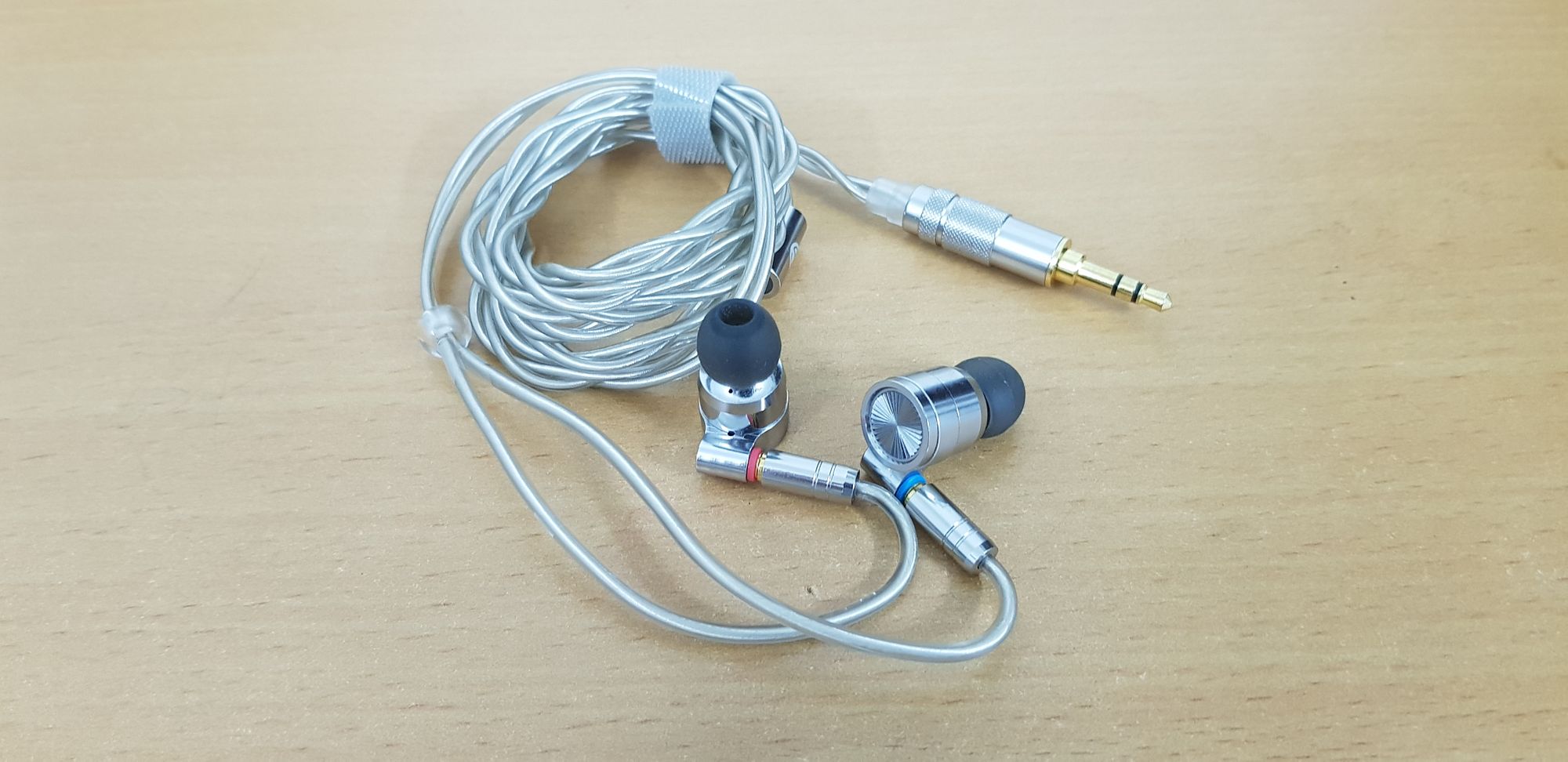
Surprisingly, while I expect a somewhat thin sounding notes from the T4 after hearing its predecessor, the reality seem different. Vocal for some reason sounds thick and while I am not that impressed with the T4 on many "weeb" song in my music library like 凋叶棕 - ためすがめ due to the high-pitched "anime" females vocal doesn't sound right to my taste, I was able to enjoy songs with male vocals like Baio - PHILOSOPHY! more than I usually do.
Comparing to T2 and T3, the Tin Hifi T4 tuning is less bright and less aggressive, providing a more balanced sounds across the board. It also sounds different from the newly released BLON BL-03: The Tin T4 is more shouty on female vocals and its bass lacks punch comparing to the BLON.
But, putting away my complaints about the tuning of the T4 which goes by my preference more than anything, the T4 note clarity is good, better than most (if not all) of the past Tin Hifi product (Yes, I think it beats the P1 technical wise, I wasn't a fan of it anyway despite the fact that it was an improvement to Tin Hifi past product at the time). Although this earphone imaging and soundstage is seemingly "average", for 110$, its technical ability seem to shoot nearly everything in this price range off the cliff which is really impressive.
Conclusion:
I usually would try to write some more of my thoughts about the IEM that I am reviewing, but this time, let just keep it short: Do I recommend the Tin Hifi T4? Yes! For 100$, in my opinion, it is the best that Tin Hifi has to offer and I see the earphone would still be relevant in the future as a solid recommendation to a lot of people just like how the T2 was. Hats off to you Tin Hifi.






